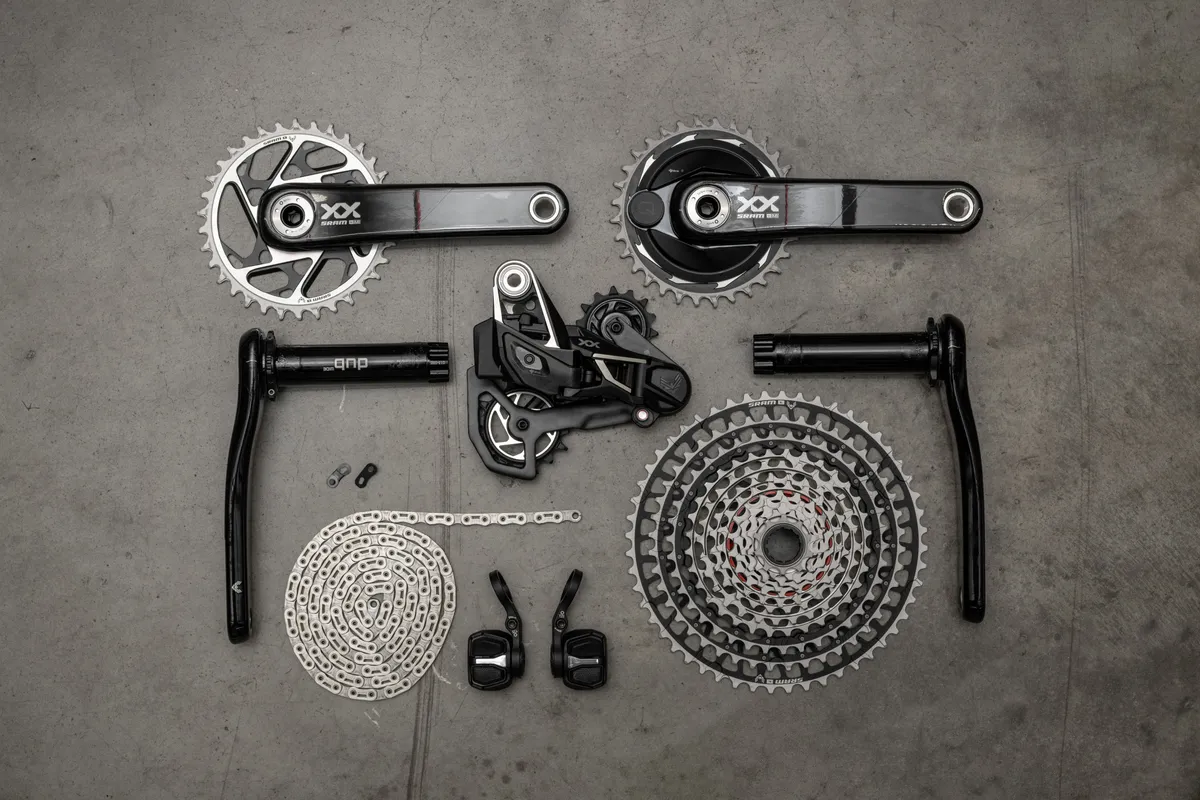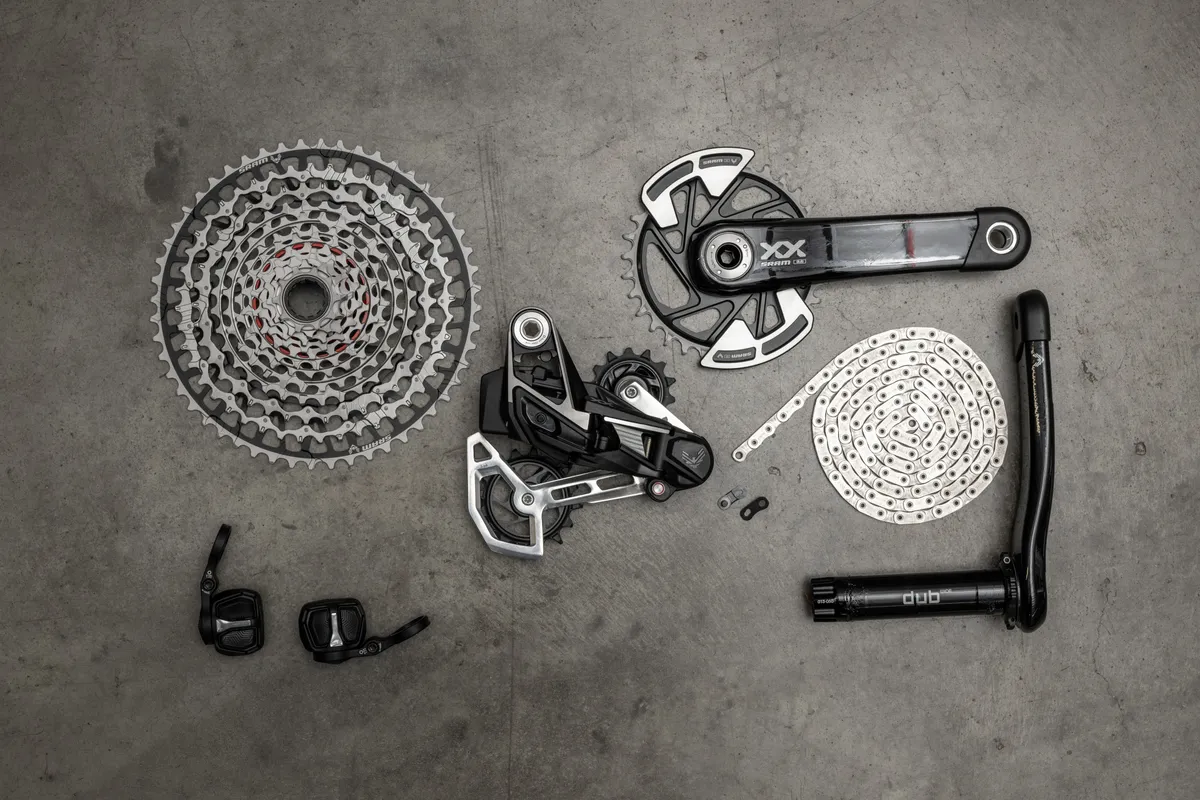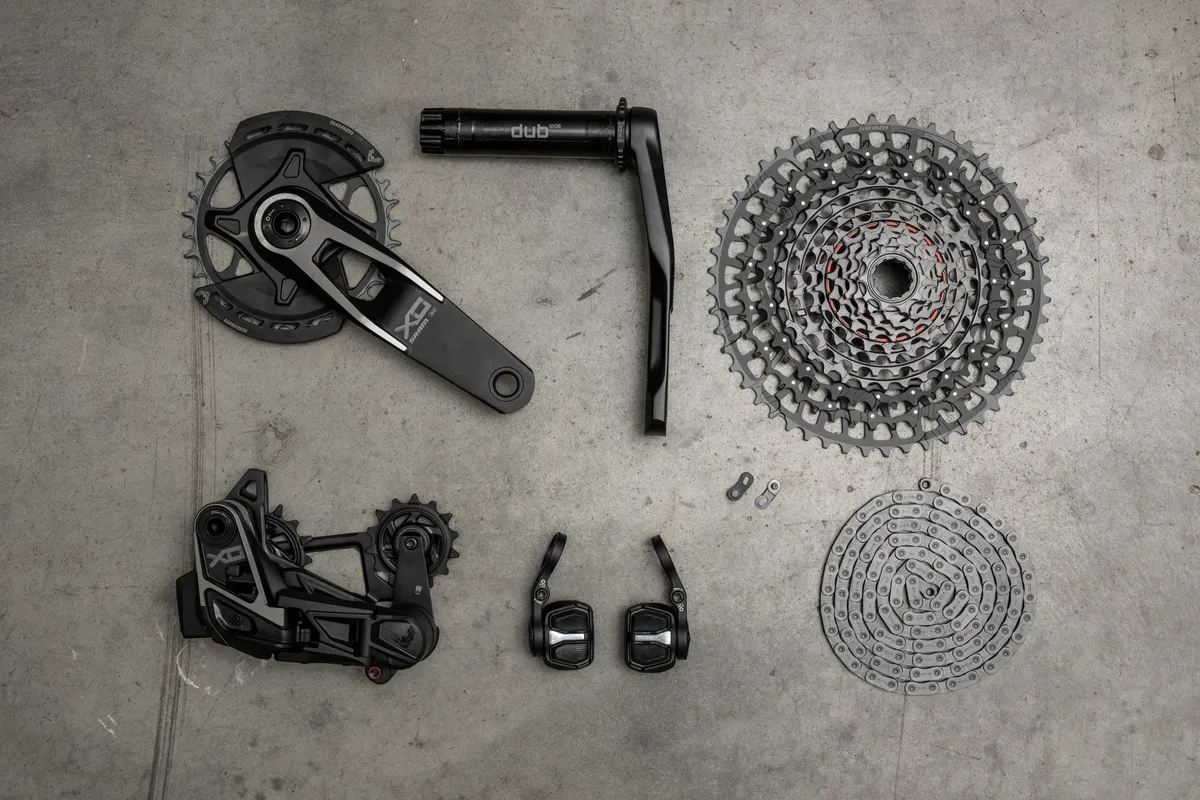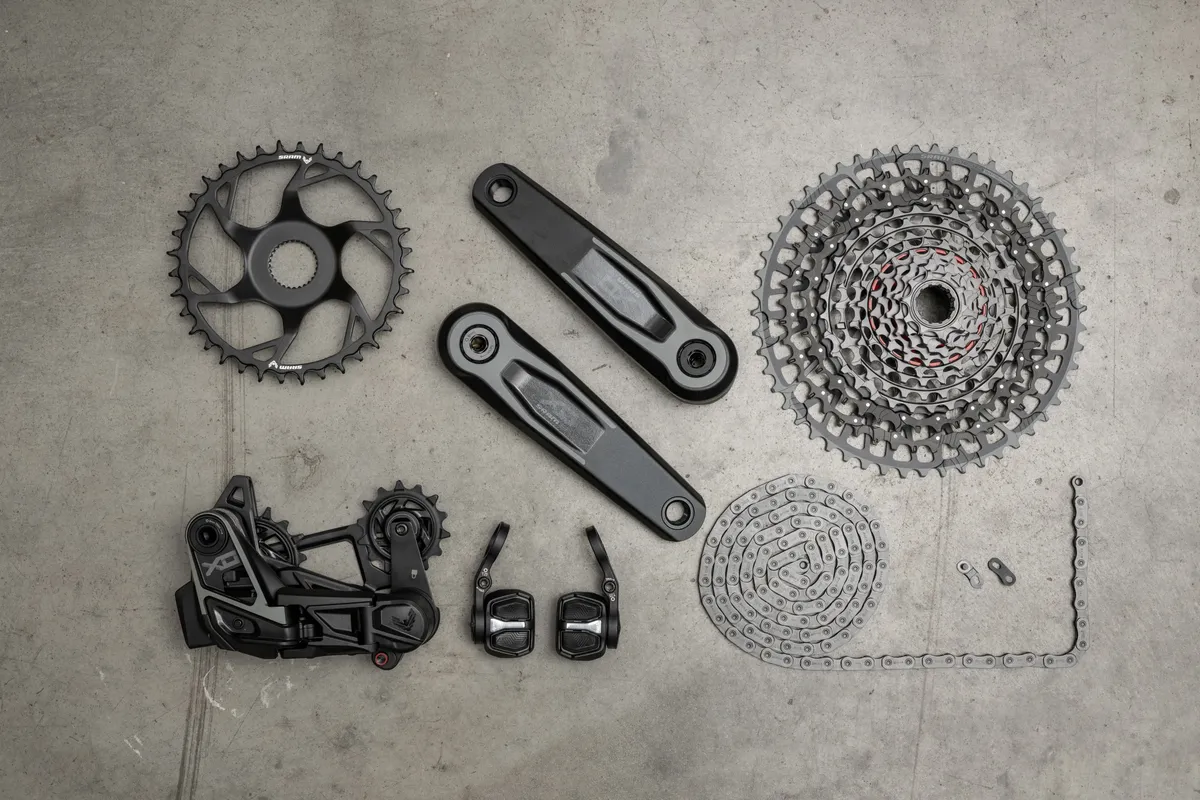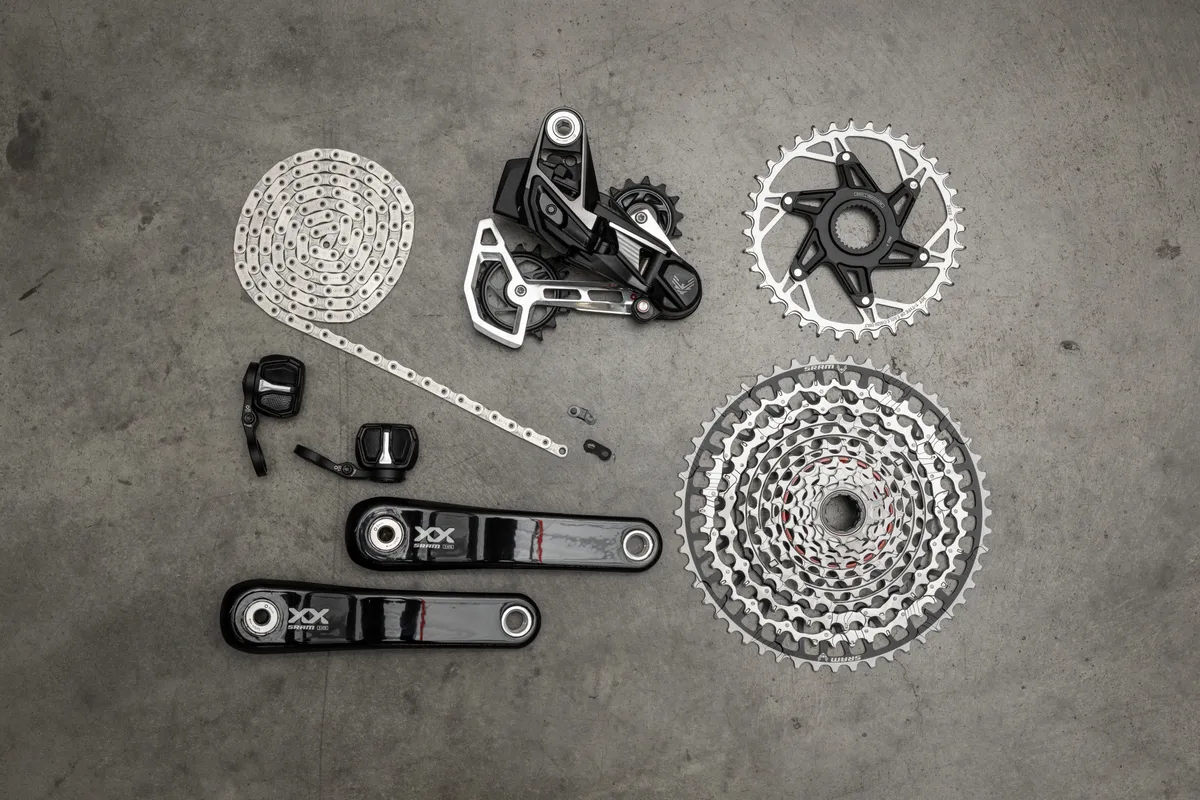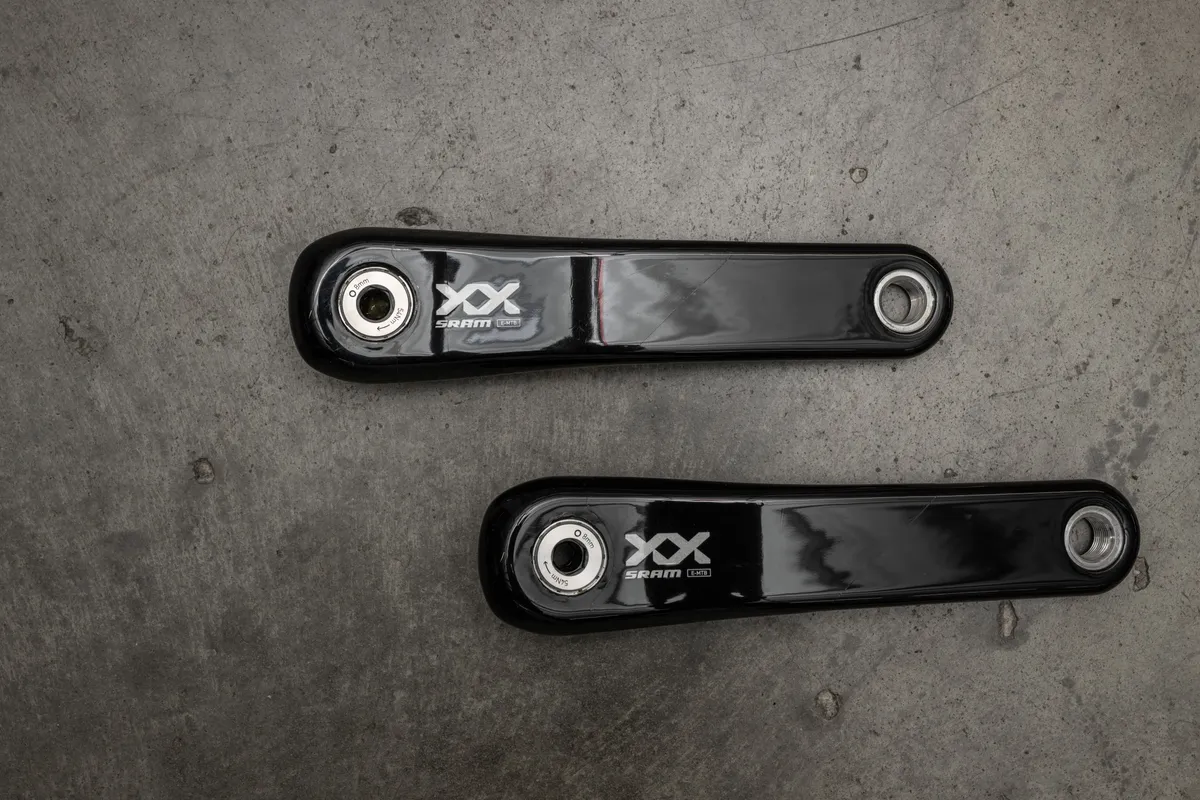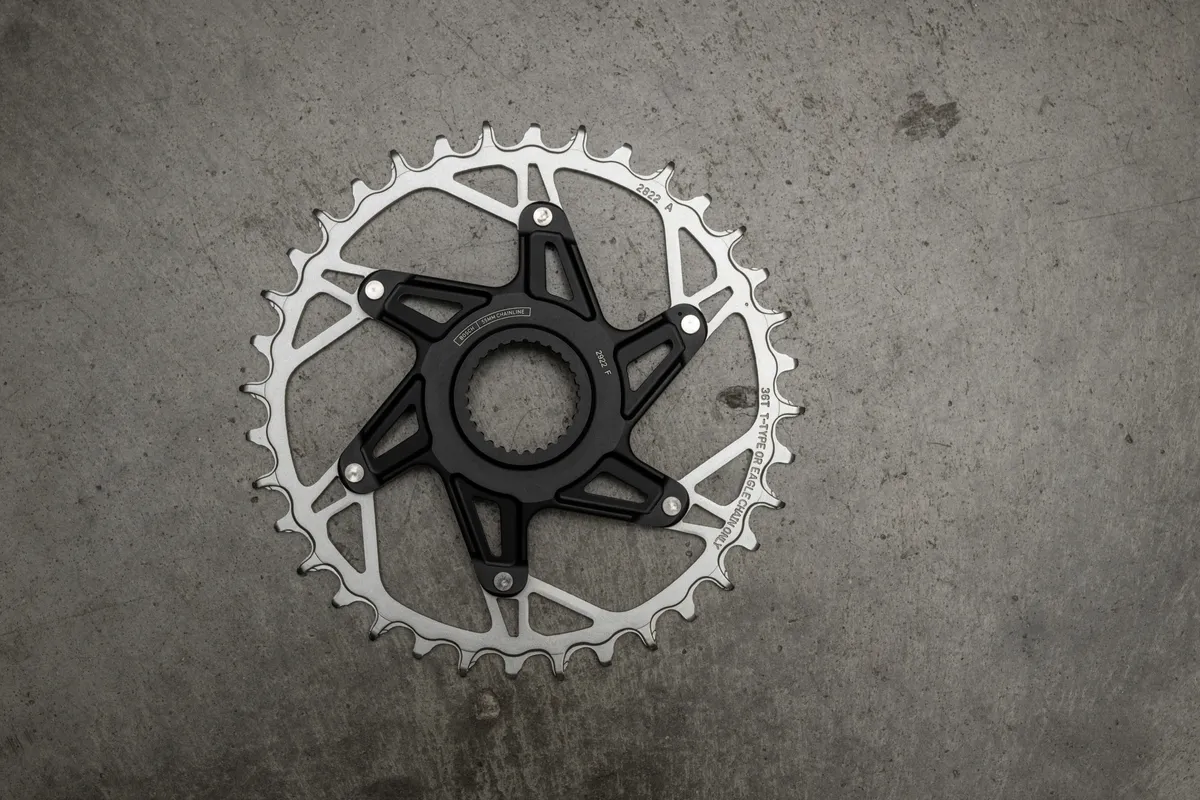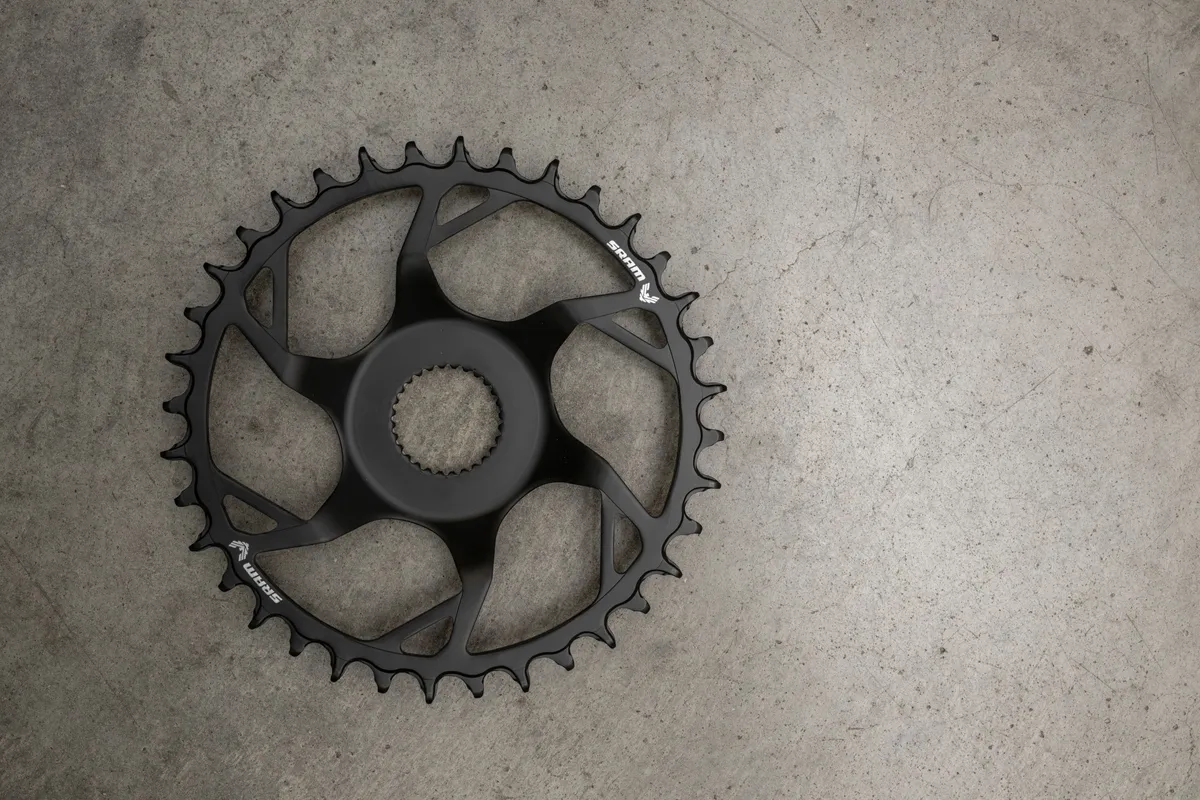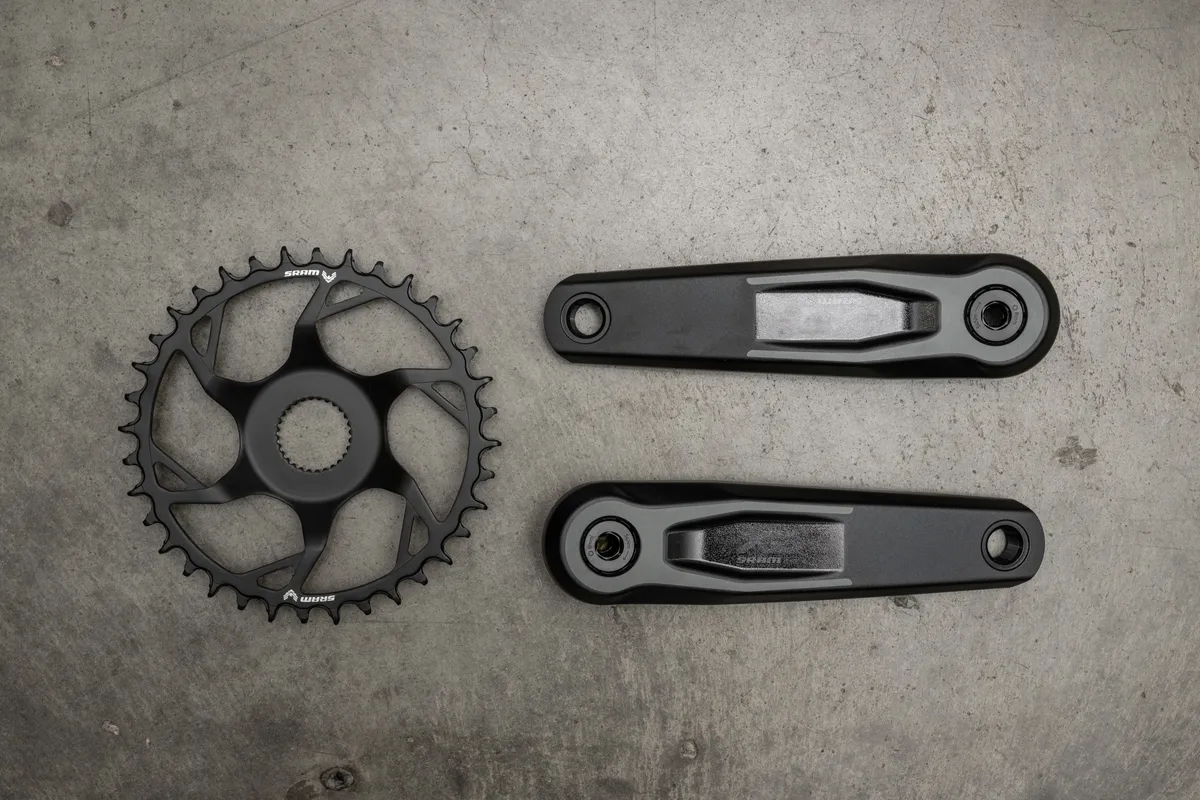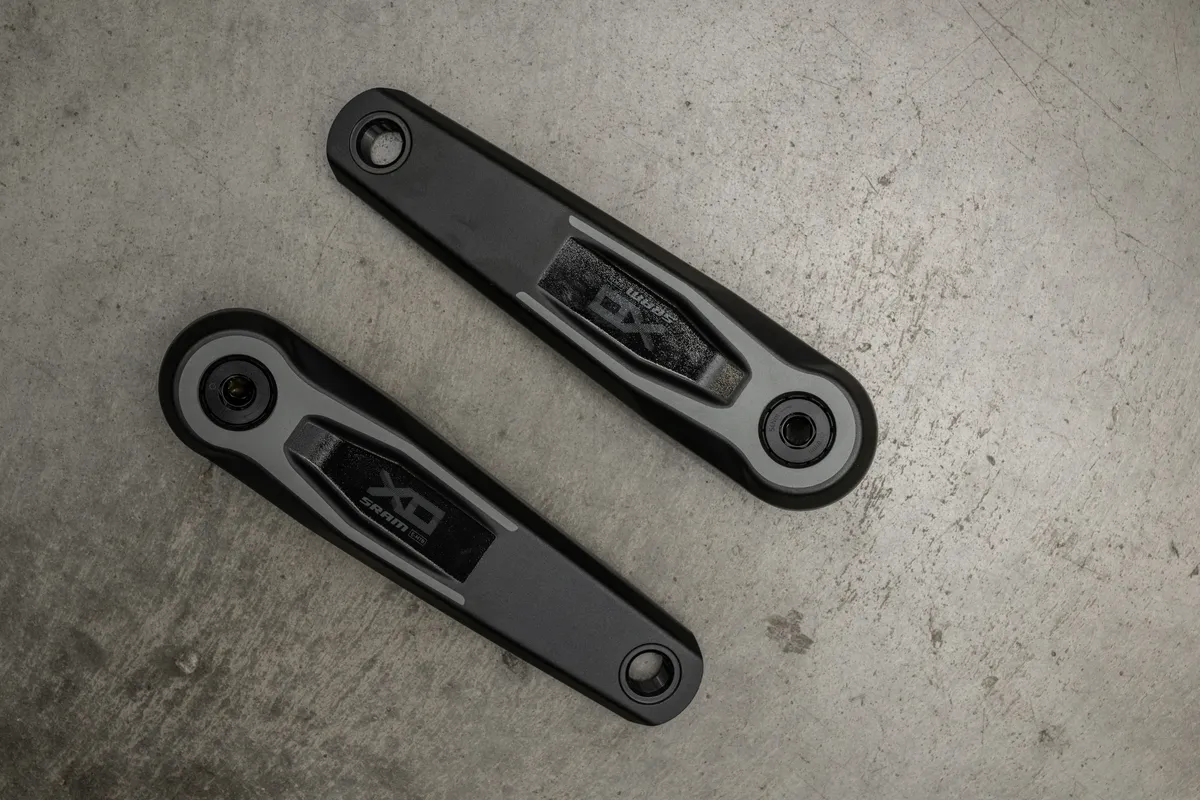SRAM’s all-new T-Type Eagle Transmission has landed, with the long-teased direct-mount design removing the need for a derailleur hanger and derailleur adjustment screws.
The innovative direct-mount design – described as the “biggest product introduction in SRAM’s history” – sees the derailleur clamp the bike’s frame at the rear wheel axle, rather than being attached to a derailleur hanger.
Removing the need for a hanger is an entirely new way of mounting a derailleur.
T-Type is a whole new system that includes all parts of a drivetrain, where each part has been designed to work together.
As a result, the new system isn’t compatible with any of the current-generation Eagle drivetrain parts, bar the AXS controller.
SRAM has also launched updated Stealth brake levers designed to match T-Type Eagle Transmission.
Eight years in the making
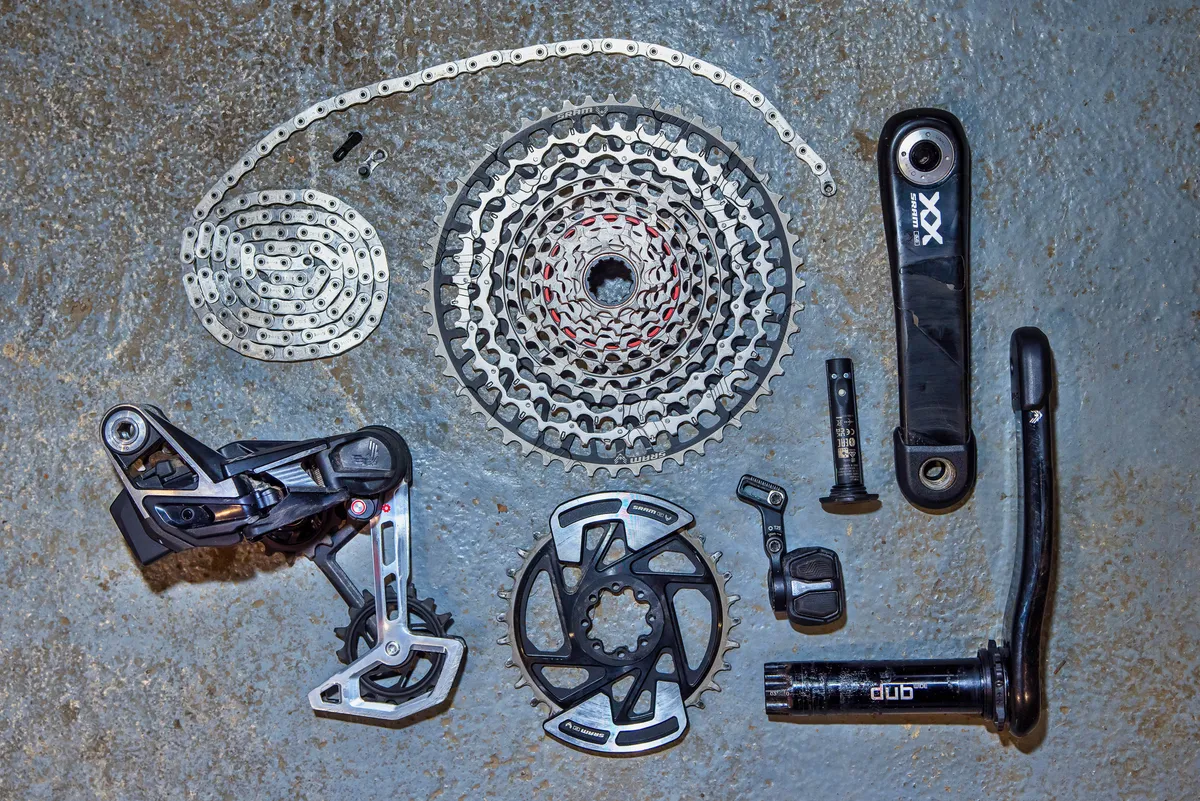
The introduction of T-Type has been nearly eight years in the making.
The derailleur’s Full Mount design takes advantage of the future-proofed dropout standard SRAM’s Universal Derailleur Hanger (UDH) launched back in 2019.
Built on three principles, the new T-Type Transmission is intended to increase drivetrain robustness and reliability, improve shifting under load and increasing ease of use and set up.
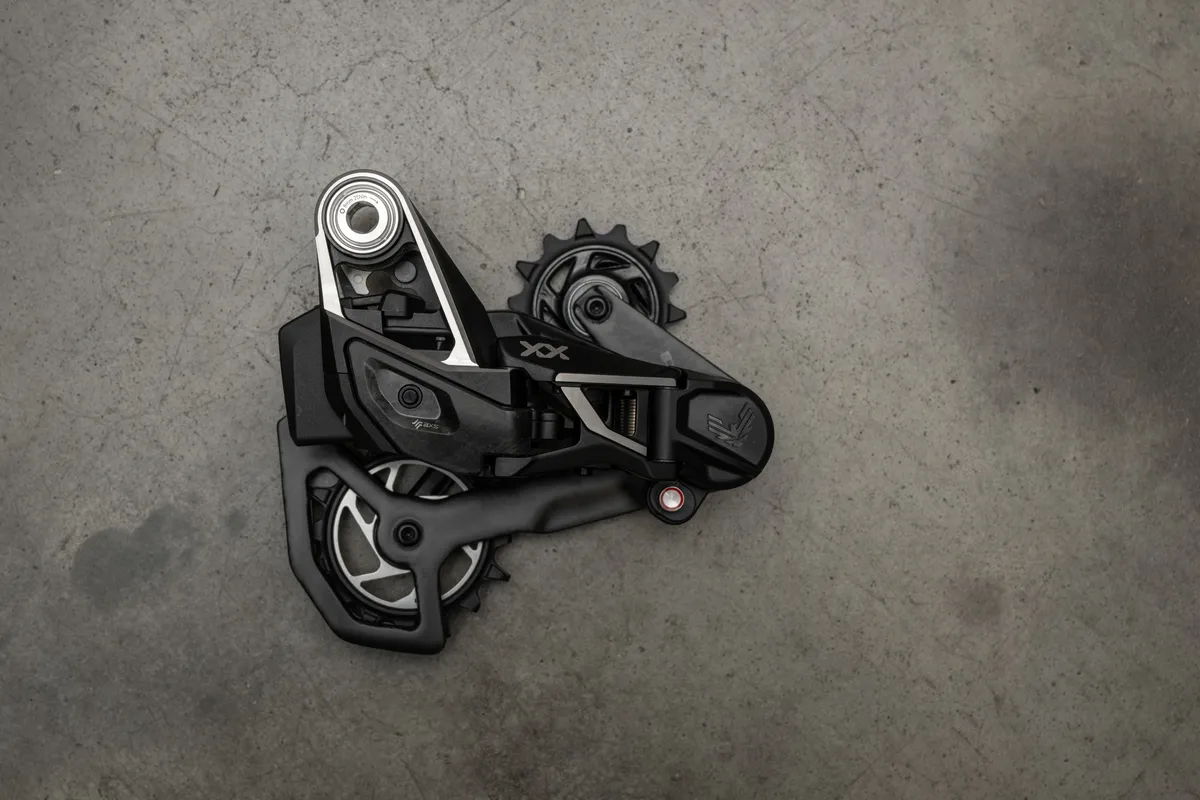
According to product manager Andreas Kölsch, it’s the “biggest product introduction in SRAM’s history”, and it’s clear why.
At launch, the new T-Type Eagle Transmission is available in three levels:
- XX SL: designed to be the lightest, highest-performing groupset
- XX: sporting burlier components
- X0: a slightly more affordable version
For full T-Type Eagle Transmission groupsets (derailleur, AXS Pod, cranks and chainring, chain, cassette) prices start at:
- X0: £1,715 / $1,599 / €1,900
- XX: £2,195 / $2,049 / €2,450 without power meter, £2,465 / $2,299 / €2,750 with
- XX SL: £2,355 / $2,199 / €2,650 without power meter, £2,890 / $2,699 / €3,250 with
Five things you need to know about SRAM’s T-Type Eagle Transmission
- It’ll only work on bikes that use SRAM’s Universal Derailleur Hanger
- The new derailleur has no b-tension or limit screw adjustment
- It doesn’t need a derailleur hanger; it mounts directly to the bike’s frame at the rear wheel axle
- The derailleur has user-replaceable components, such as the cage, Skid Plate and outer parallelogram links
- Each T-Type component is designed to work together, which means it isn’t compatible with current-generation Eagle drivetrains
If you want to study all the terminology relating to SRAM’s T-Type Eagle Transmission before reading the rest of this article, you can skip to our glossary.

You can read Alex Evans' XX T-Type Eagle Transmission groupset review and find out how to install the all-new T-Type derailleur with our handy guide.
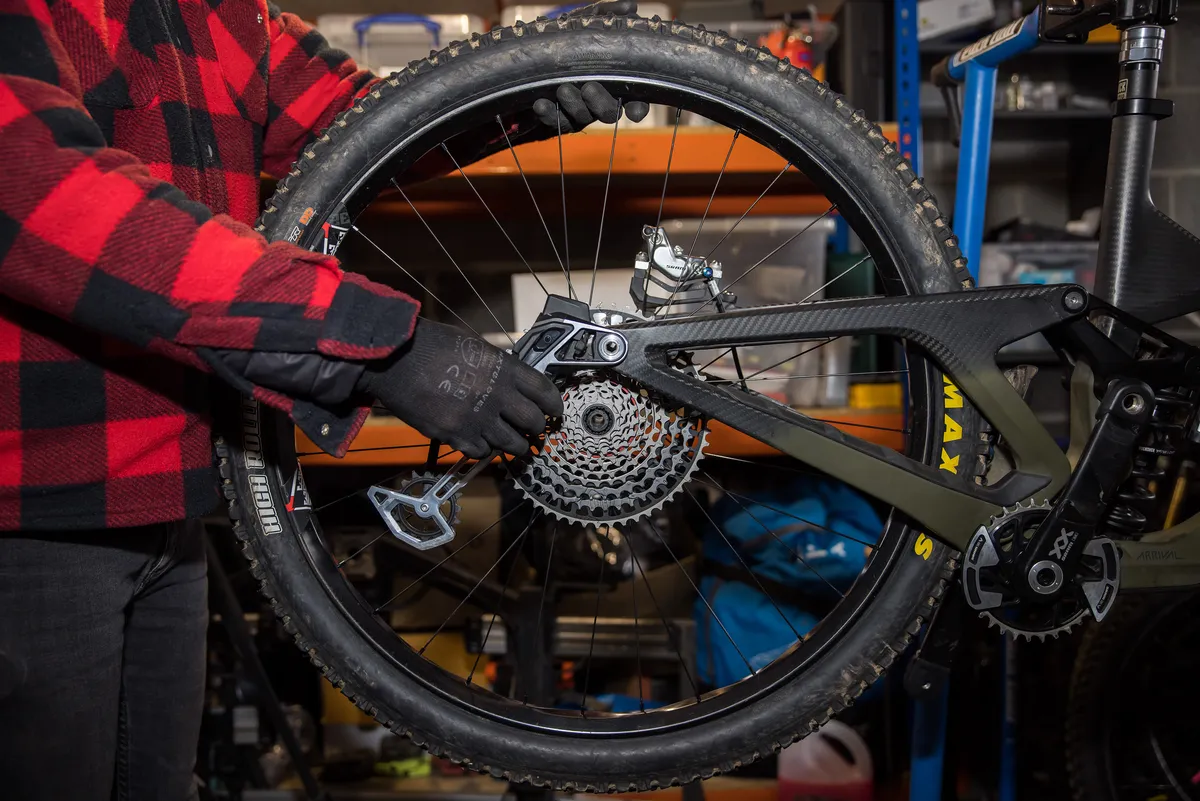
What is new with SRAM’s T-Type Eagle Transmission?
In short, all of SRAM’s T-Type Eagle Transmission components are brand new, from the derailleur to the AXS Pod Controllers.
Although no one component is more important than another, some – such as the chain and derailleur – have had bigger, more visible changes compared to the pedal cranks and chainrings, for example.
SRAM T-Type Eagle Transmission derailleur – goodbye, derailleur hangers
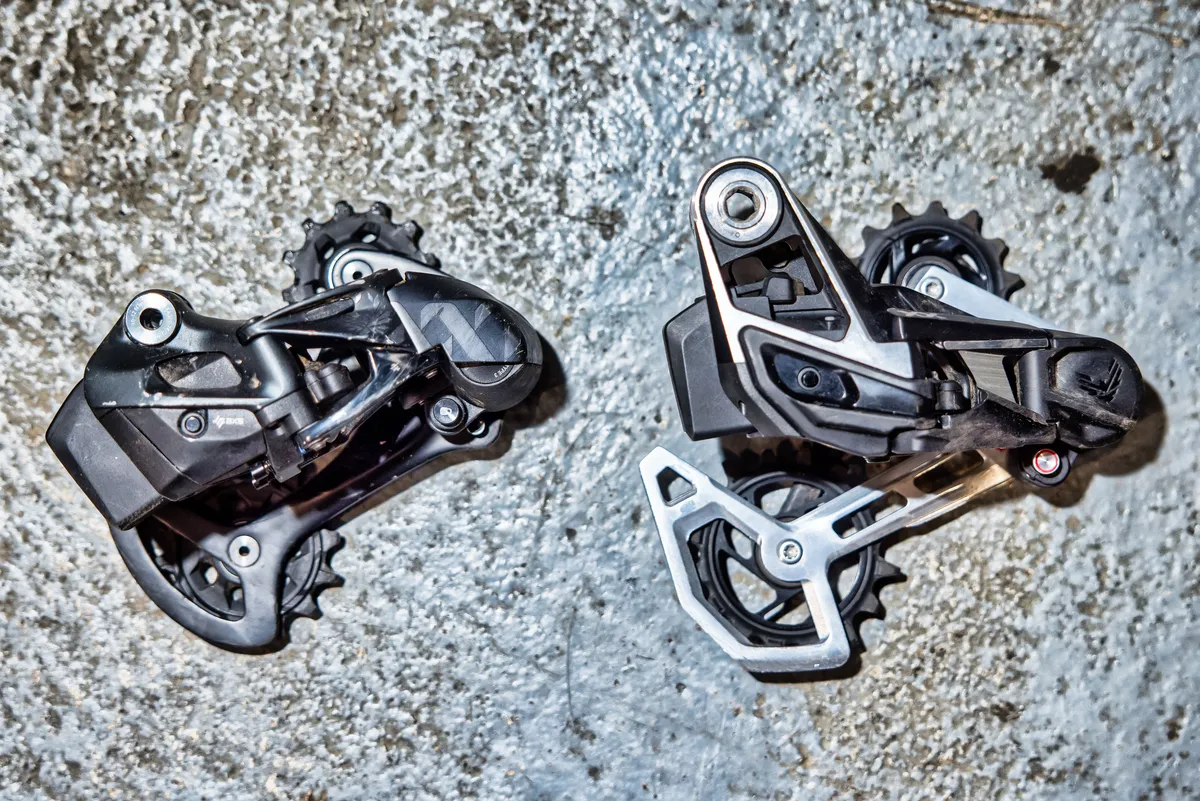
Receiving the most striking redesign is the rear derailleur, available in XX SL, XX and X0 versions.
Removing the need for a derailleur hanger means it mounts directly to the bike’s frame at the rear wheel axle, using SRAM’s Hangerless Interface.
The rear wheel axle is used as the derailleur’s mounting point.
The axle is the centre point of the cassette, therefore the derailleur’s upper jockey wheel is in the same relative position to the cassette no matter which gear is selected, or how tight or slack the chain is.
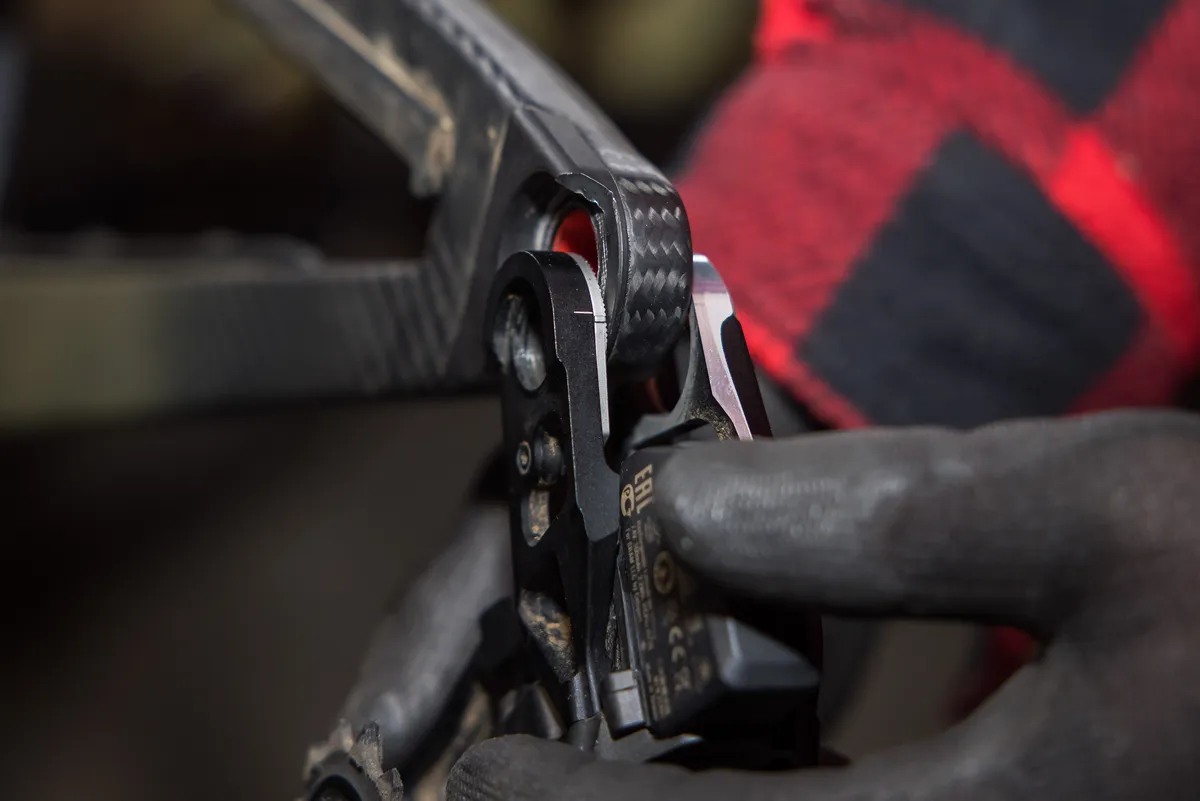
Derailleurs mounted via a hanger are offset in relation to the cassette; their mounting point is below the cassette’s centre. T-Type addresses this with its Full Mount design.
Frames with SRAM’s UDH have the Hangerless Interface, required to fit T-Type’s new design.
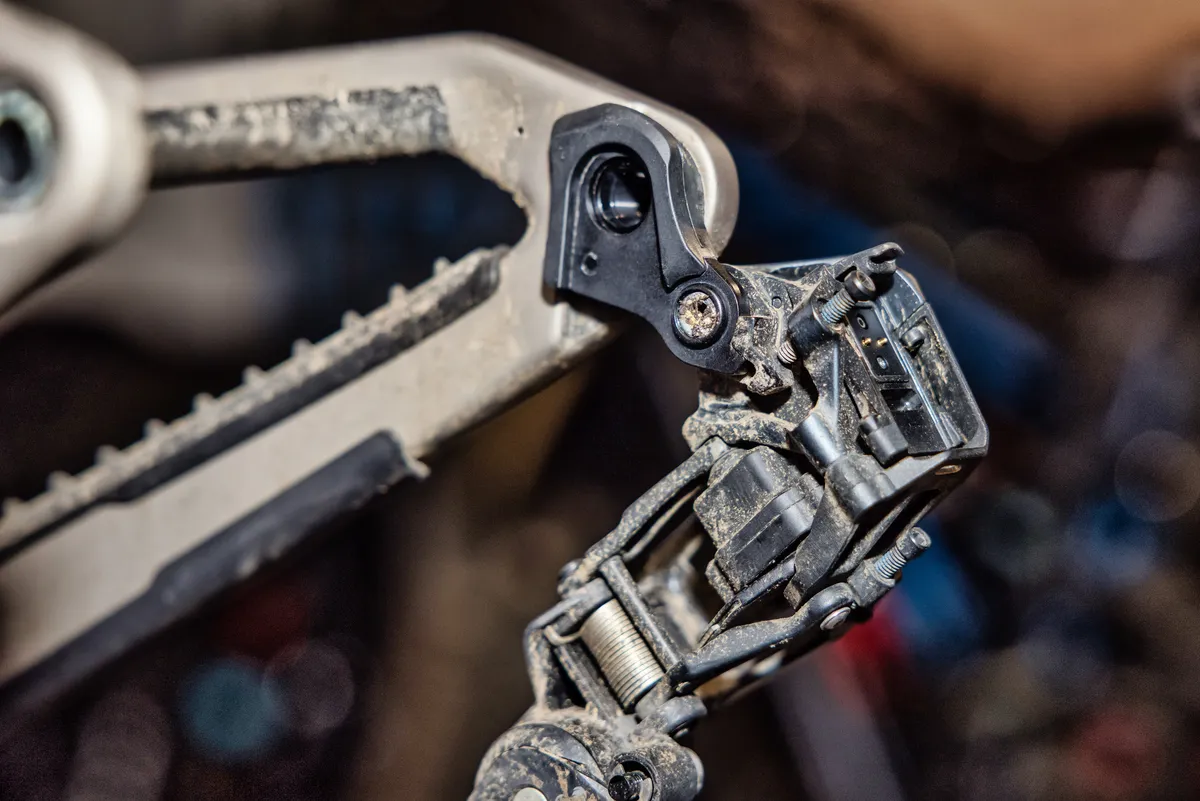
The Hangerless Interface replaces the UDH.
The derailleur attaches to the bike’s bare dropout, with its machined aluminium Full Mount struts clamping the frame from either side of the Hangerless Interface.
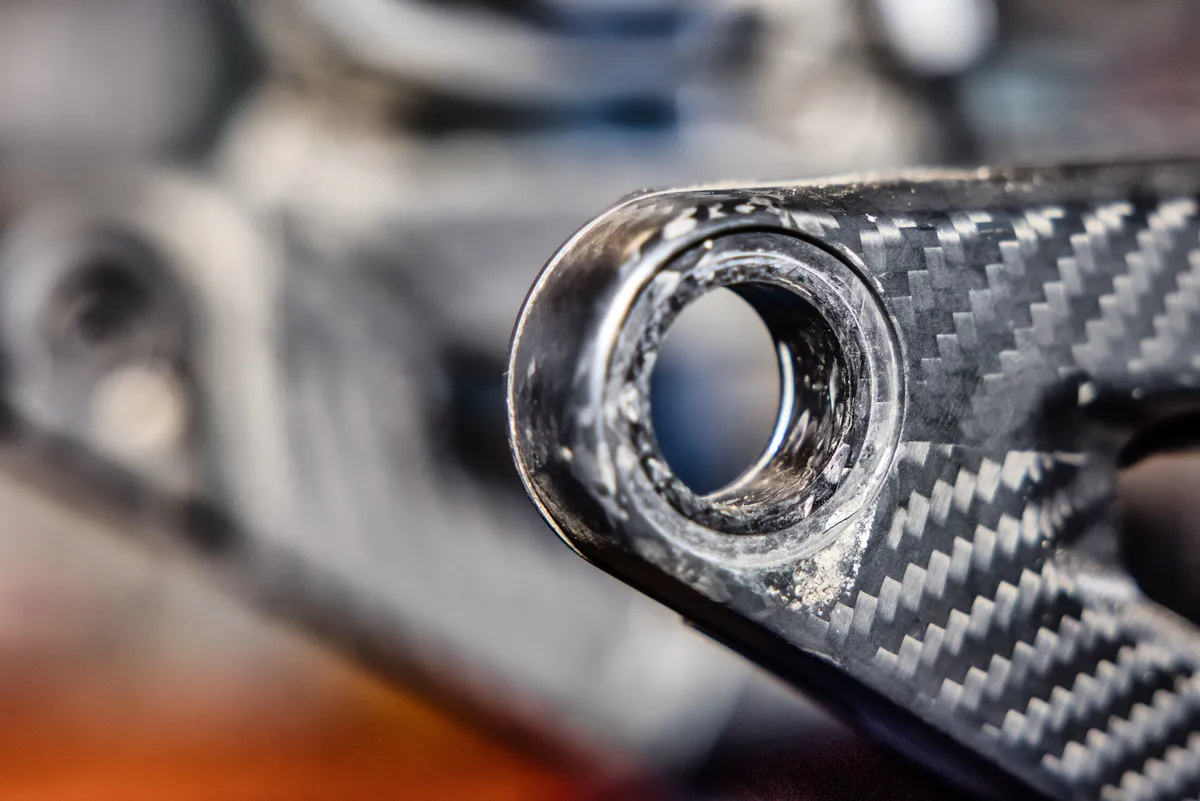
An axle with a bushing passes through the dropout, enabling the derailleur to pivot if required.
No adjustment required
Key to removing the derailleur’s limit and b-tension adjustment screws is its Full Mount design.
This eliminates variations in distance between the derailleur and cassette, and therefore the need for limit screws.
Micro adjustments – where the derailleur’s position can be trimmed using the AXS smartphone app or the AXS Pod Controller – are still present, and may need to be used to fine-tune its position on the cassette.
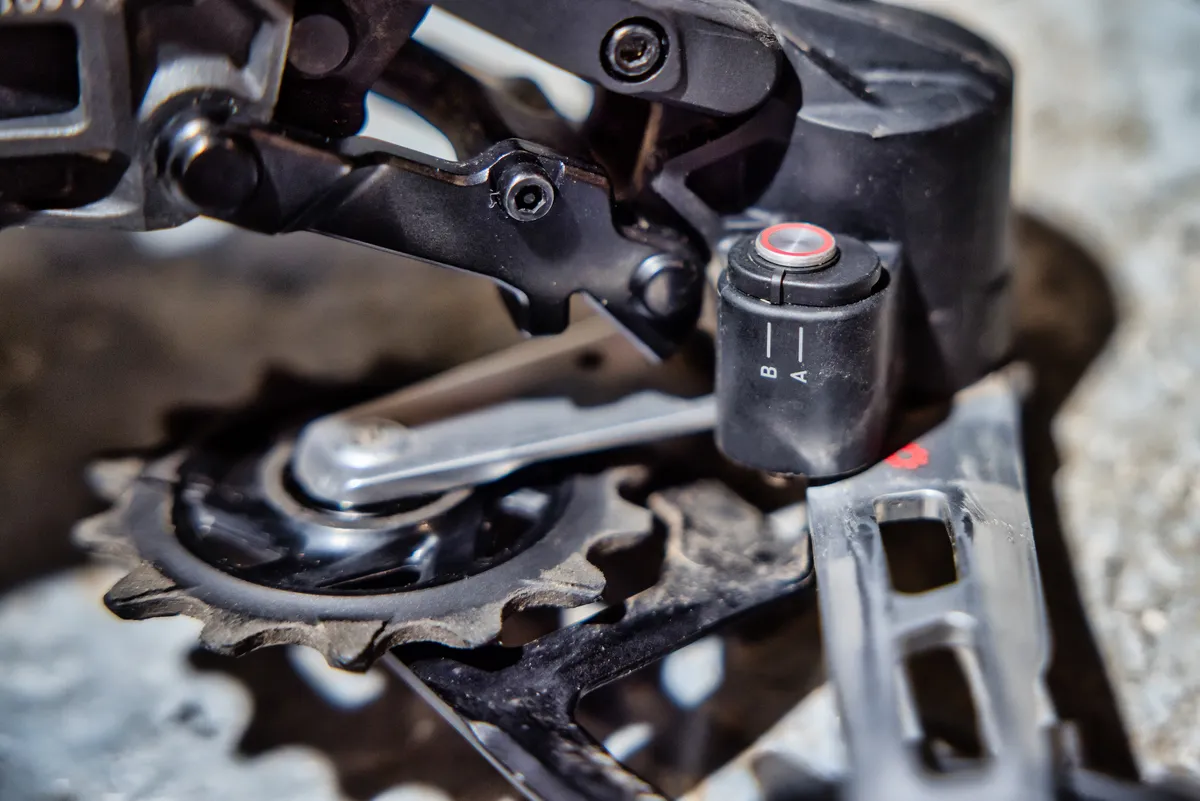
Initial or re-installation setup is required, but, in our experience, the T-Type Eagle Transmission setup process is easier than the current-generation Eagle drivetrains.
The derailleur’s Cage Mode button – called the Cage Lock button on previous models – is used to hold the cage in a forward position for wheel removal. It has a secondary position called the Setup Key that’s used during installation.
Putting the derailleur in the Setup Key position and engaging the dedicated setup cassette sprocket (gear seven) makes setting the correct chain gap between the derailleur cage and cassette possible without needing to adjust the b-tension for a given bike’s suspension sag.
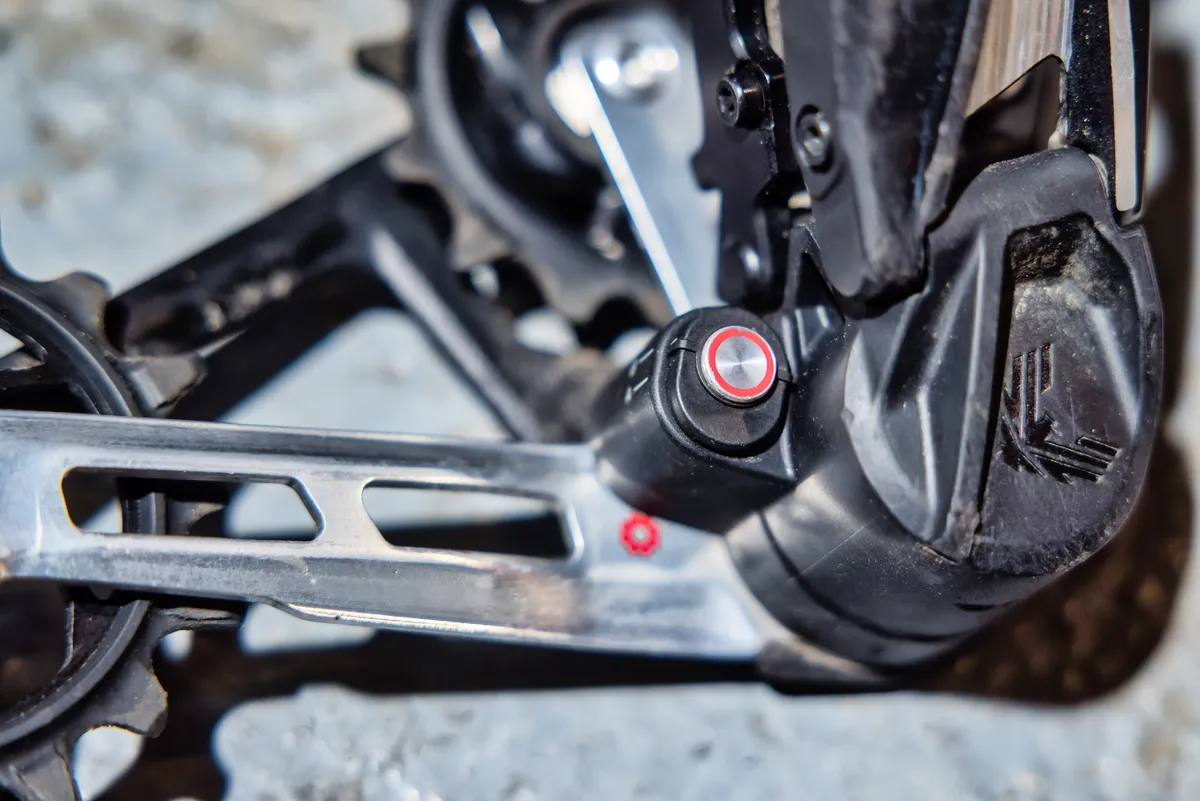
This eliminates the need for the b-tension adjustment.
The Setup Key also accommodates different or changing chain lengths, as required by varying suspension designs and chainstay figures.
SRAM has produced a chain length chart that uses chainstay length (from 425mm to 470mm) and chainring size (30t to 42t) to define the ideal number of chain links for any given bike.
The derailleur’s design and setup procedures negate the need for derailleur adjustability.
Modularity and replaceable parts
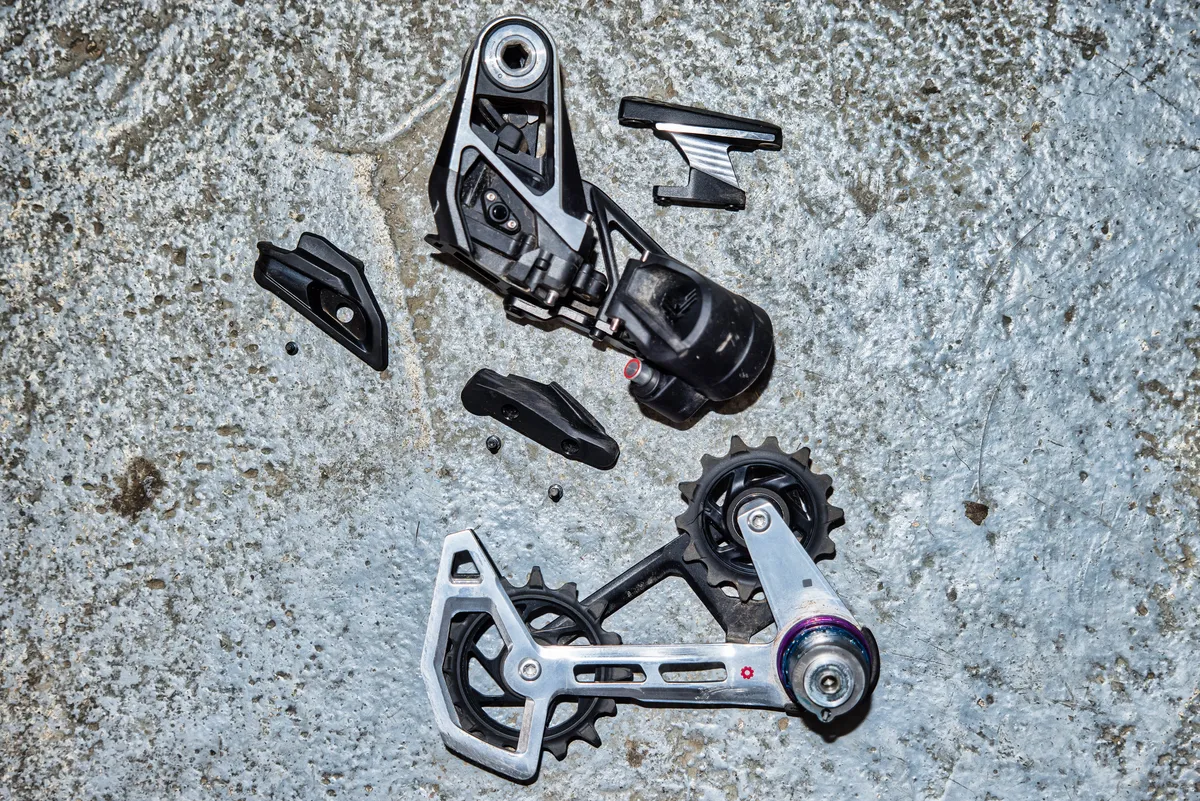
According to SRAM, the derailleur’s design also “delivers unprecedented robustness”.
Derailleur modularity means sections of it are replaceable.
A user-replaceable Skid Plate on the derailleur’s widest portion is attached using 2mm Allen bolts.
The parallelogram’s lower and upper links are also replaceable and are held in place with 2mm and 2.5mm Allen bolts.
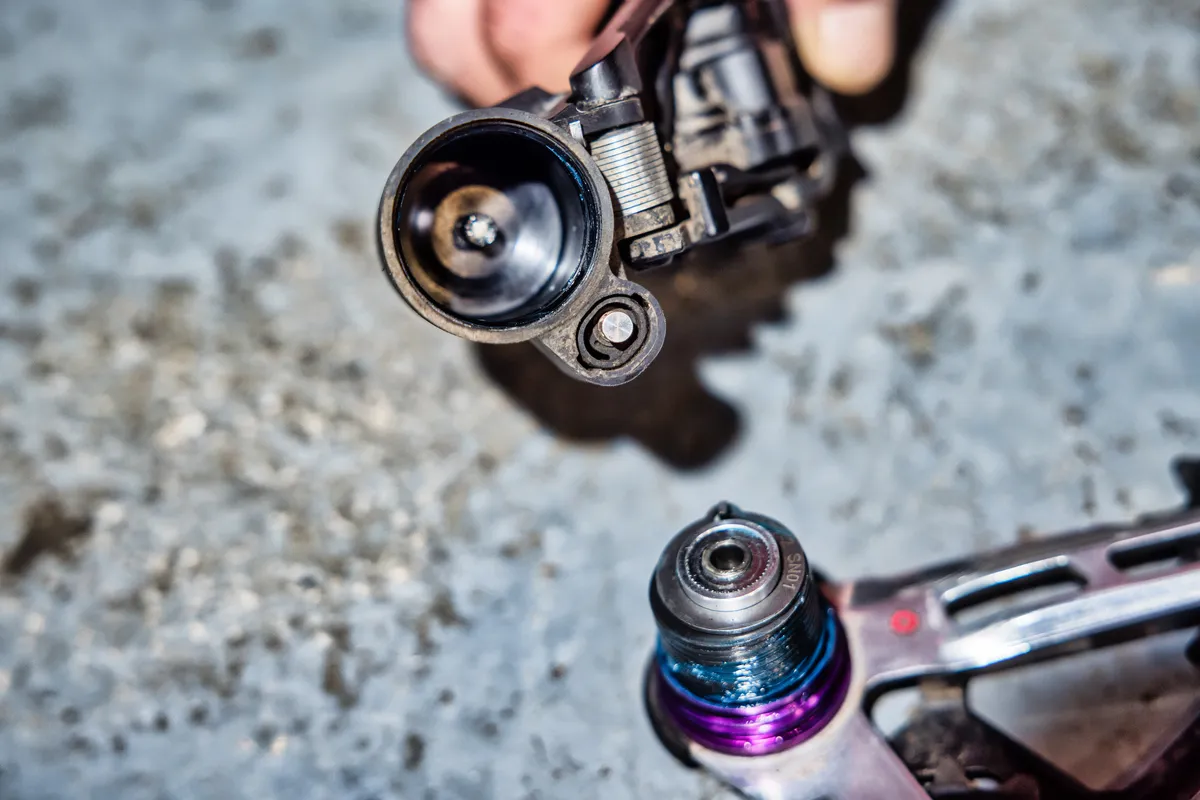
Both pulley wheels can also be replaced using Torx 25 bolts.
Its cage can be removed and replaced requiring no tools, simply unscrewing from the derailleur’s p-knuckle.
Although the clutch or damper mechanism’s tension remains un-adjustable (Shimano still holds the patent for adjustable-tension derailleur clutches), it’s now integrated into the removable cage.
Increased T-Type derailleur clutch tension addresses one of the Eagle drivetrain’s main criticisms. However, according to SRAM, battery life is reduced marginally because it requires more motor force to change gear.
T-Type is compatible with SRAM’s current AXS batteries, used on Eagle drivetrains, Reverb AXS dropper posts and Flight Attendant components.
SRAM claims making T-Type derailleurs replaceable and rebuildable increases their lifespan.
Performance enhancements
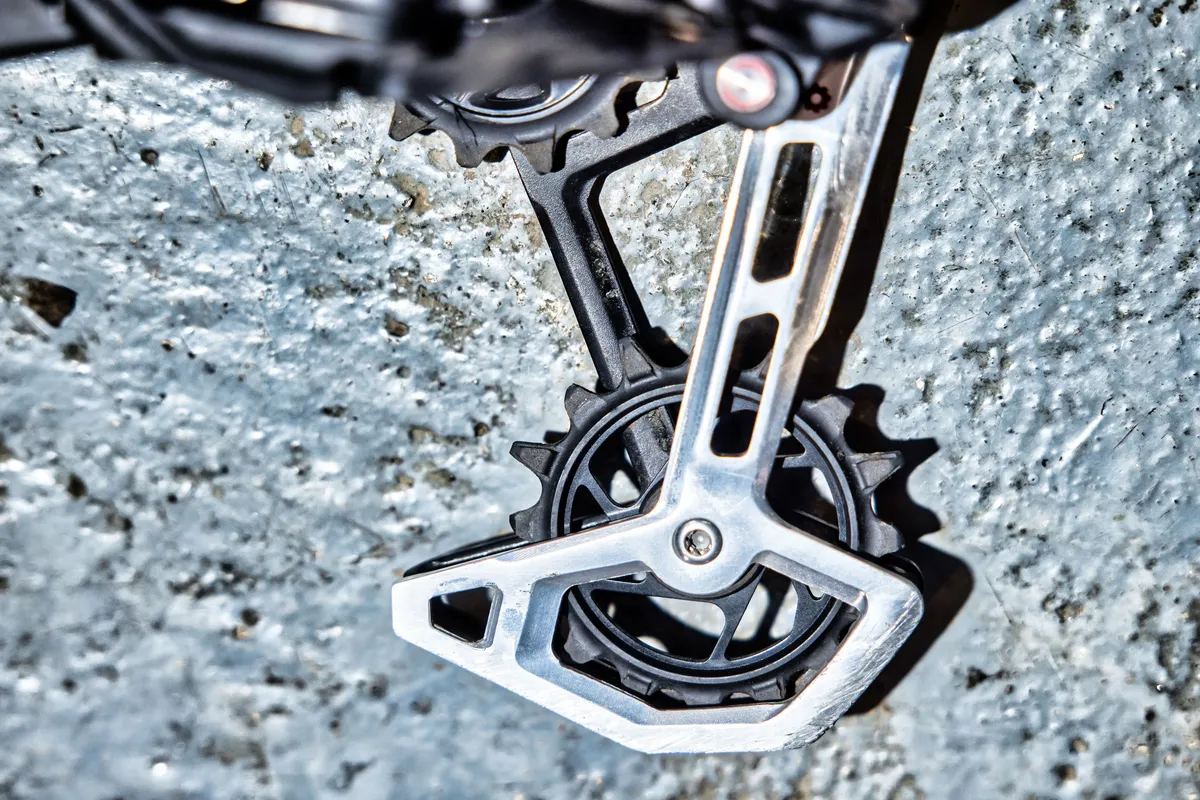
A host of important derailleur redesigns have been made to further improve performance.
Traditionally, derailleurs are positioned so the b-knuckle cants or angles it towards the chainring.
SRAM’s new T-Type derailleur’s b-knuckle is straight.
Instead, the cage is now angled so the bottom pulley is in line with the chainring, while the top one lines up with the cassette’s entire range of sprockets.
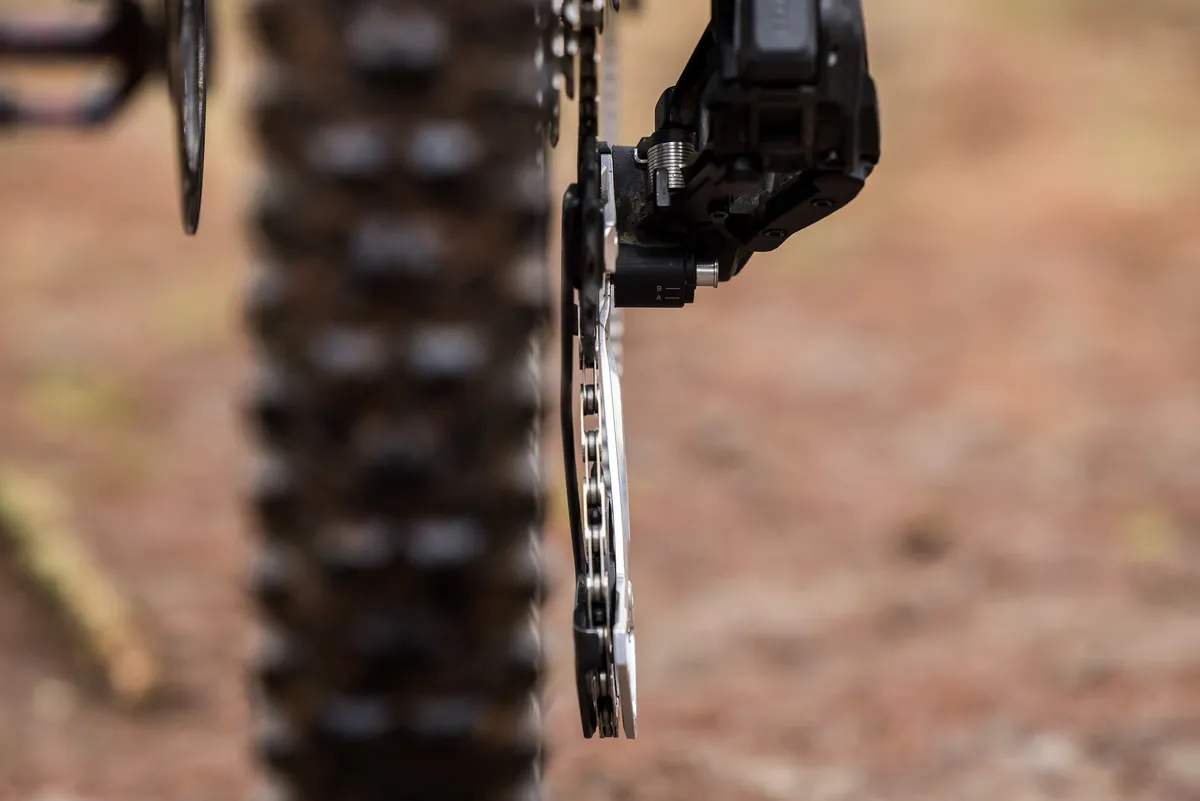
The cage has a 'yaw angle' or ‘kink’ across its length to do this, with it appearing ‘bent’ from the rear.
It’s dubbed 'Inline Cage' because it's always in line with the chainring and cassette.
Next up is the Magic Wheel, which refers to the derailleur’s lower jockey wheel.
The Magic Wheel is only available on XX SL and XX derailleur models. It can be purchased as a separate upgrade on X0 derailleurs.
The toothed outer portion of the wheel can rotate independently from the spoked centre section. If blocked, the outer portion of the pulley continues to rotate on the stationary centre’s spokes, reducing the chances of chain jam and damage.
To reduce object ingestion, the cage surrounding the front of the lower jockey wheel has a special shape. The pulley wheel teeth are designed to expel objects as the wheel rotates.
AXS damage defence features
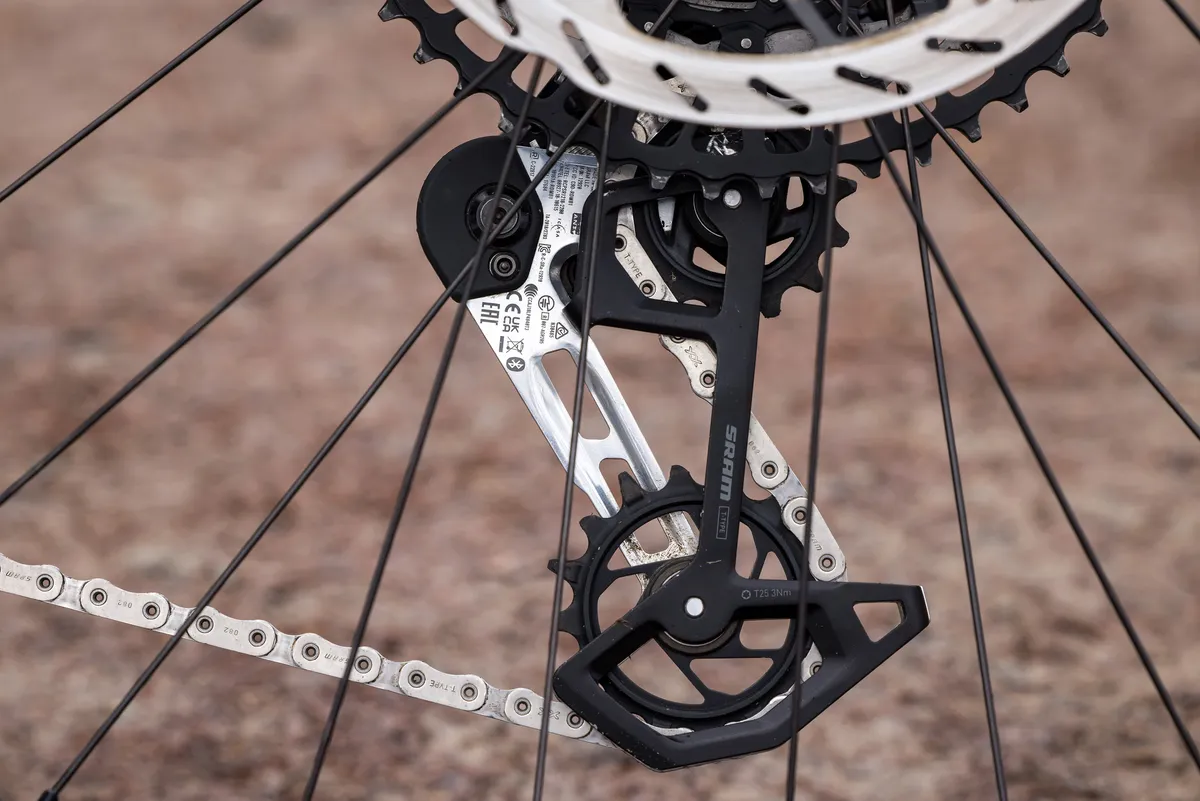
Like the current-generation Eagle AXS drivetrains, the new T-Type derailleur features SRAM’s overload clutch.
The derailleur’s motor and gearbox disengage during hard impacts, enabling the derailleur to move out of harm’s way. Post-impact, the motor re-engages, returning the derailleur to its original position.
For this iteration, SRAM has implemented new protective measures.
Despite the absence of limit screws, the derailleur still can’t enter the wheel’s spokes.
The cage has a stopper plate, contacting the cassette’s largest sprocket before it goes into the spokes.
An additional stopper prevents it from going outboard too far.
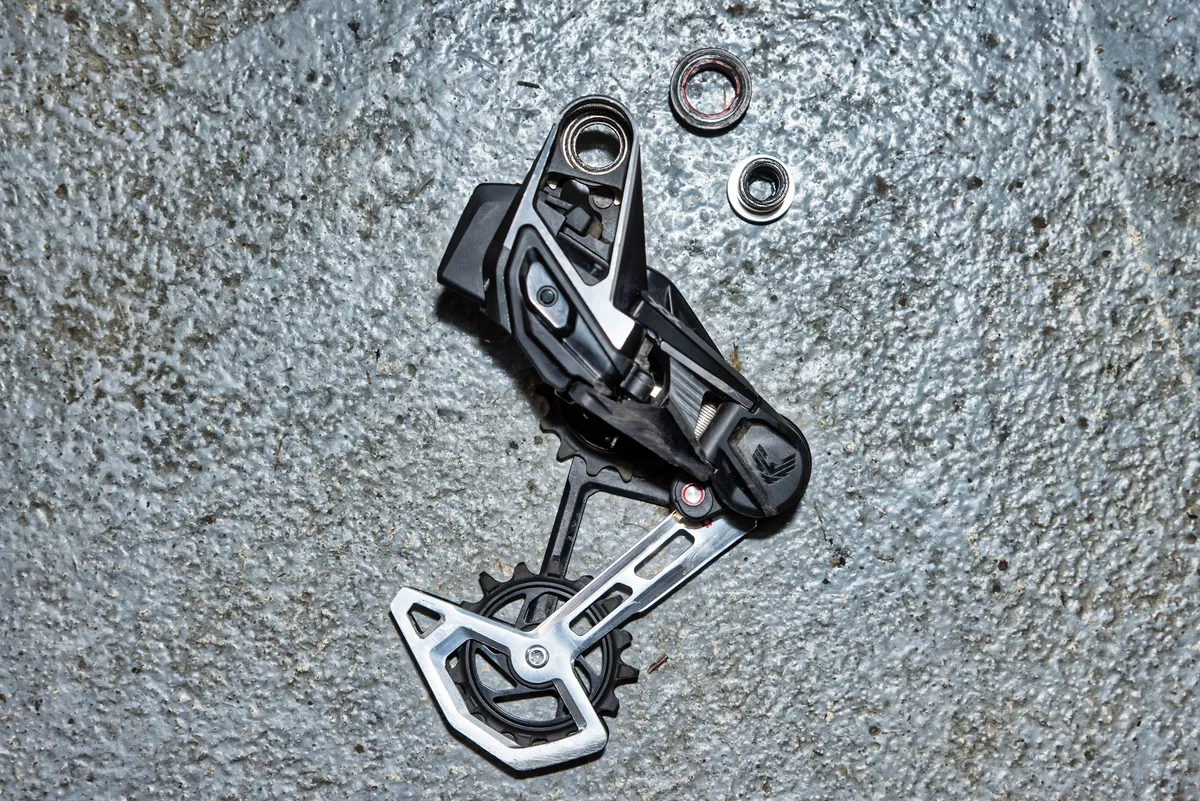
To protect from large frontal impacts, the derailleur can rotate rearwards on its Full Mount.
SRAM tested the derailleur’s durability, where it survived impacts of up to 60 joules, and withstood 6,000Nm of force before its plastic components began to deform.
According to SRAM, the new derailleur is 10mm further inboard than Eagle AXS drivetrain derailleurs, further reducing the chances of impact damage.
Many hours of laboratory and real-world testing have given SRAM the confidence to claim the derailleur has “unprecedented strength”.
SRAM T-Type Eagle Transmission AXS Pod Controller
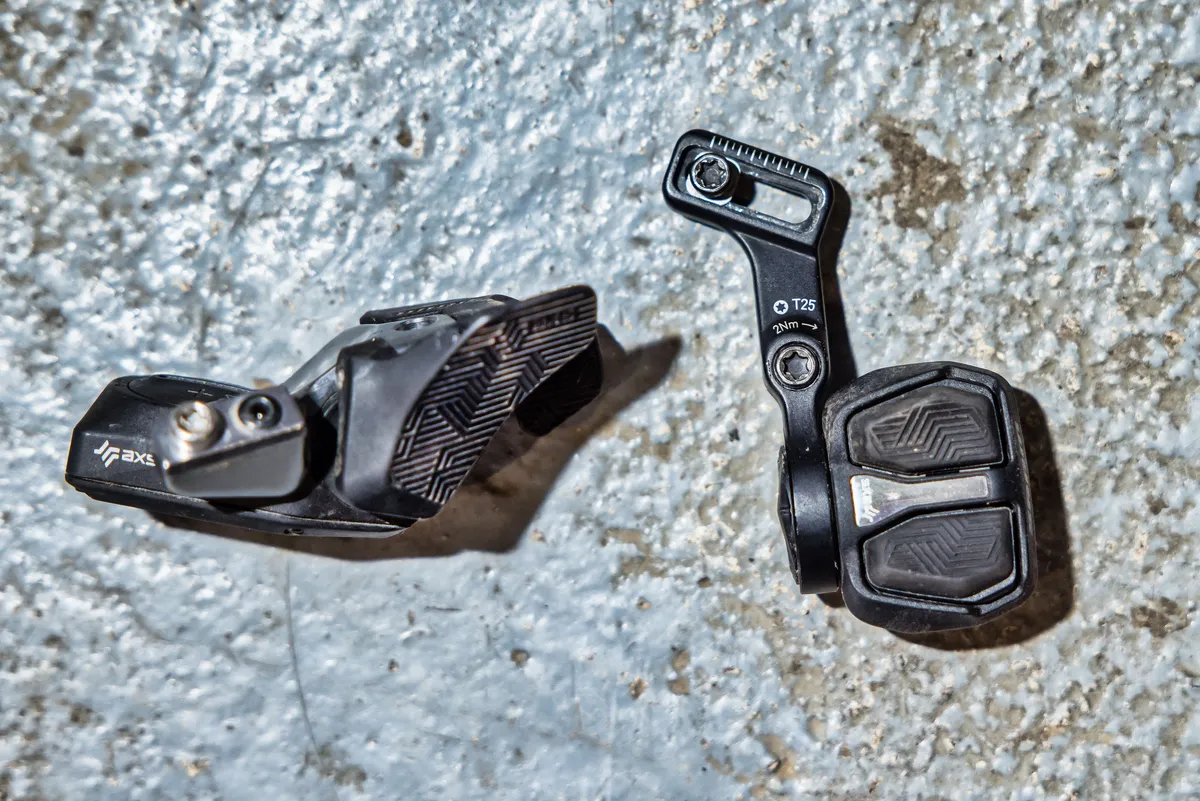
T-Type has redesigned shifters, now called AXS Pod Controllers.
The Pod Controllers eschew the previous-generation AXS controller’s analogue shifter copycat design, now with an identity of their own.
Instead of the Rocker Paddle or original AXS controller buttons, Pod Controllers have two forward-facing buttons that sit above one another.
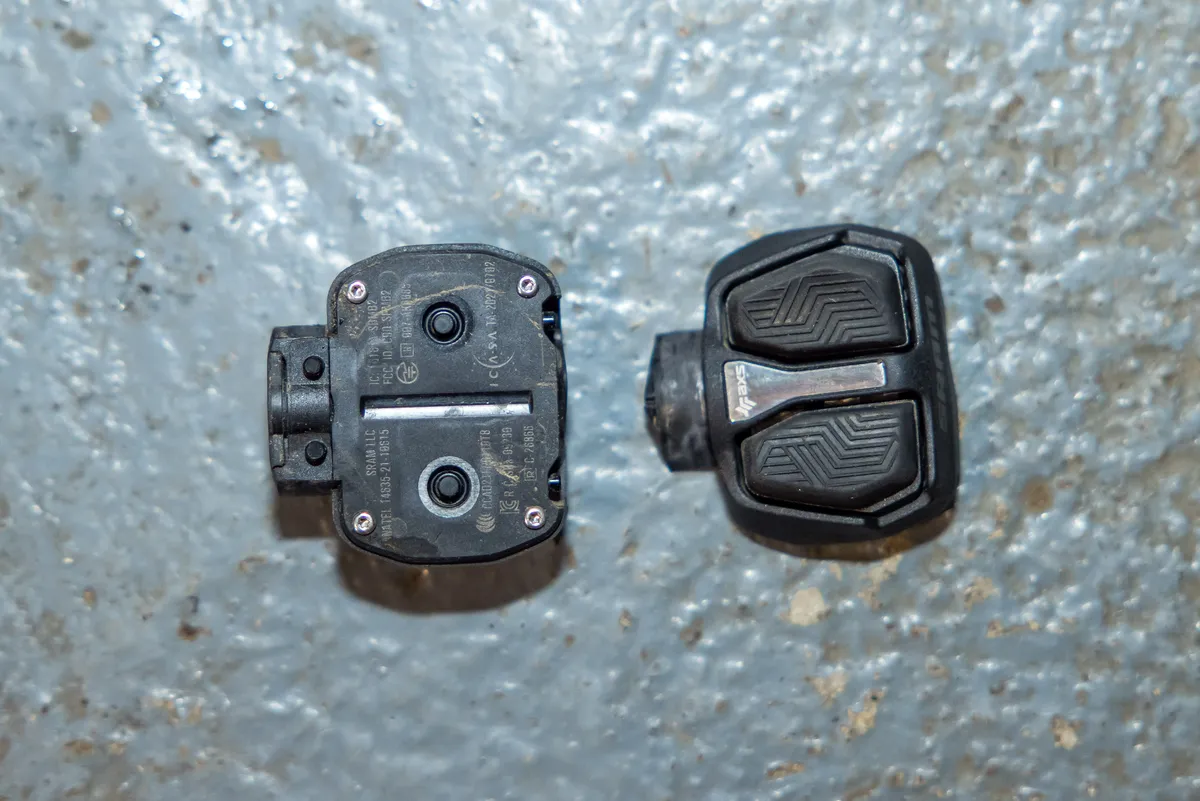
The Pod’s button functions can be assigned in the SRAM AXS smartphone app to perform tasks such as shifting up or down the cassette or operating a RockShox Reverb AXS seatpost.
Thanks to their flippable design, they can be fitted on the left-hand or right-hand side of the bar.
Two versions are available (Ultimate and standard), with the Ultimate model getting interchangeable concave or convex buttons.
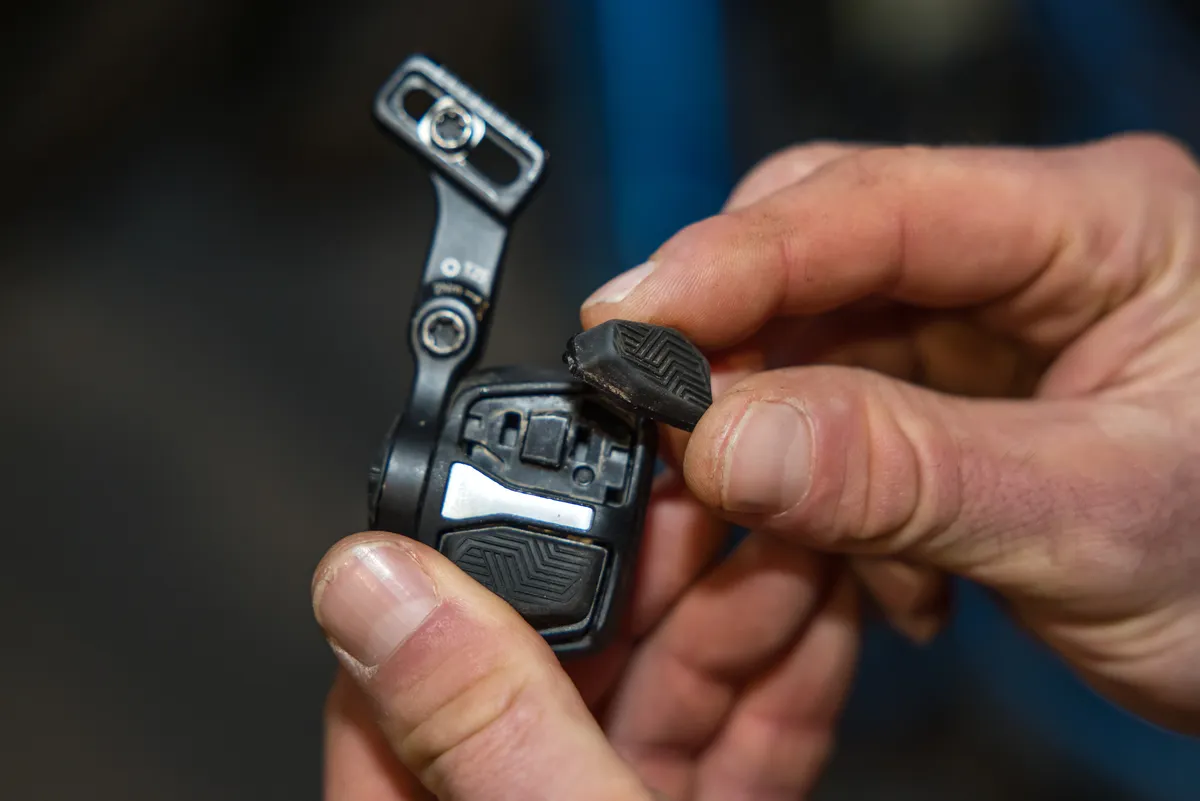
Pod controllers can be broken down into their constituent parts, where the electronics and ergonomic portion can be split.
Although SRAM didn’t say for sure, Pods could be customised with more or different control options to come.
User repairability could also be possible; if the electronic portion of the Pod breaks, a replacement could be installed easily.
There are two mounting options for the Pods.
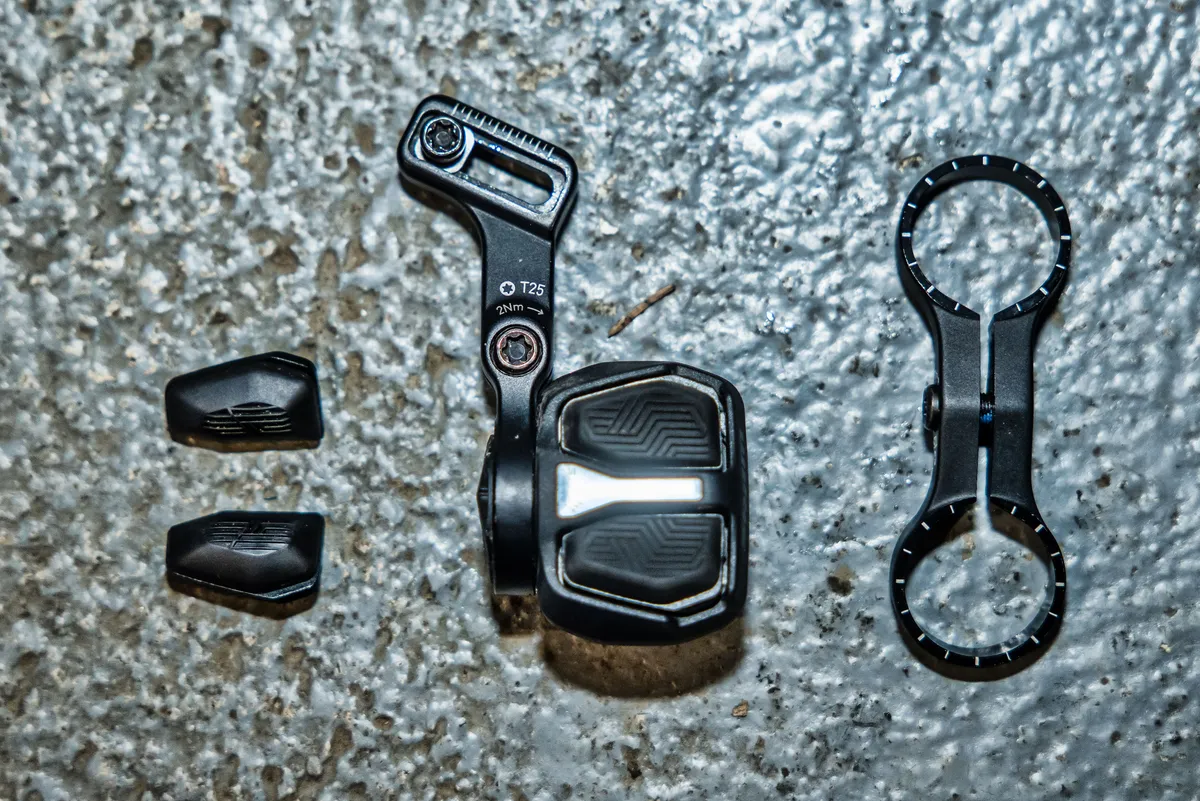
First is the all-new Infinity Clamp. Sharing its looks with an infinity loop (hence the name), the Pod’s mounting interface is the same diameter as the handlebar, so the clamp can be run with either end on the bar or the Pod.
The Infinity Clamp uses a single Torx 25 bolt to clamp the bars and Pod, but doesn’t ‘open’, so needs sliding onto the handlebars.
The clamping band is thin, so positioning it to fit with brake levers, ebike remotes and personal preferences should be easier.
Second is the Bridge Clamp. This replaces SRAM’s Matchmaker X direct-mount system, but functions similarly.
Instead of two horizontal mounting positions, the Bridge Clamp has 16mm of sliding adjustability, and the Pod can be angled on the clamp.
Fore and aft adjustment remains the same as SRAM’s Matchmaker X, however.
SRAM T-Type Eagle Transmission cassette, chain and chainring
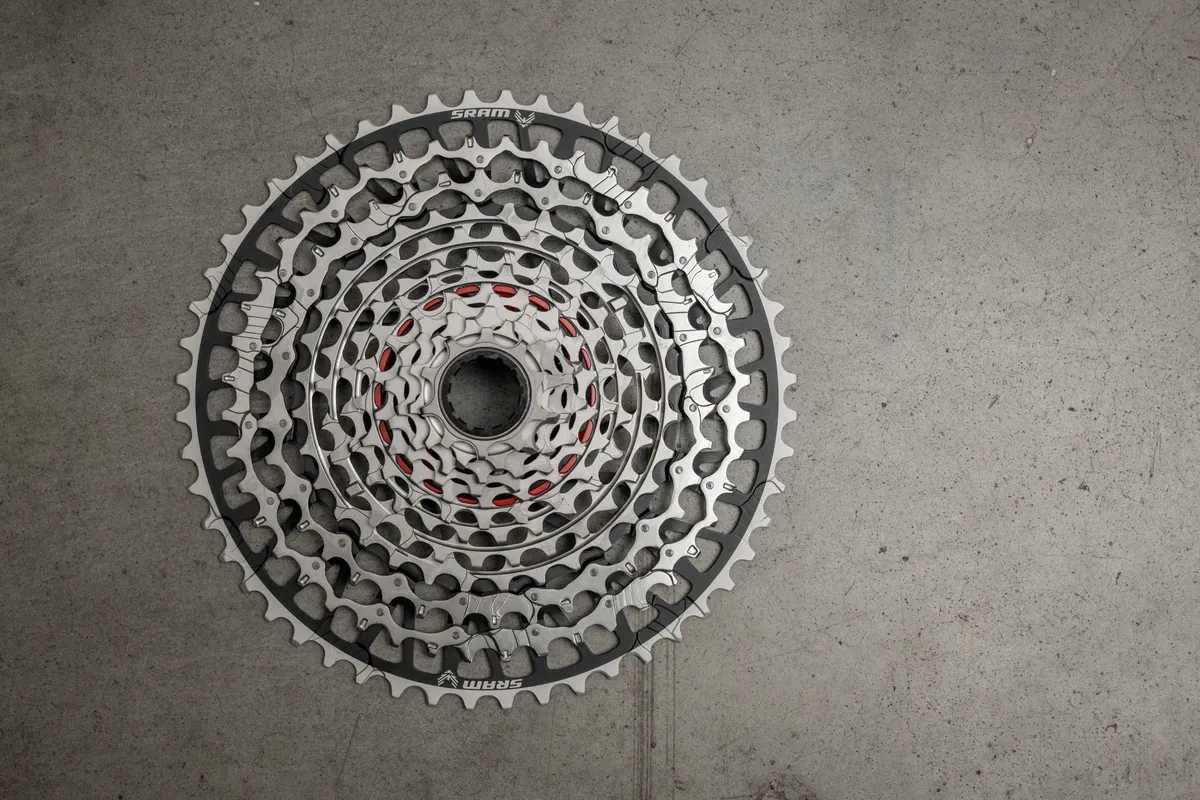
Eagle Transmission cassettes have been redesigned, their teeth now using SRAM’s alternating narrow–wide teeth thickness X-Sync design.
The chain fits on the cassette in a specific way, and if it is placed incorrectly, after one full revolution it ‘resets’ to the correct position.
Combined with X-Sync teeth, the cassette has specific shift lanes that permit or block the chain from moving to the next gear.
Specific shift ramps, according to SRAM, mean the chain is always in permanent contact with the cassette as it shifts.
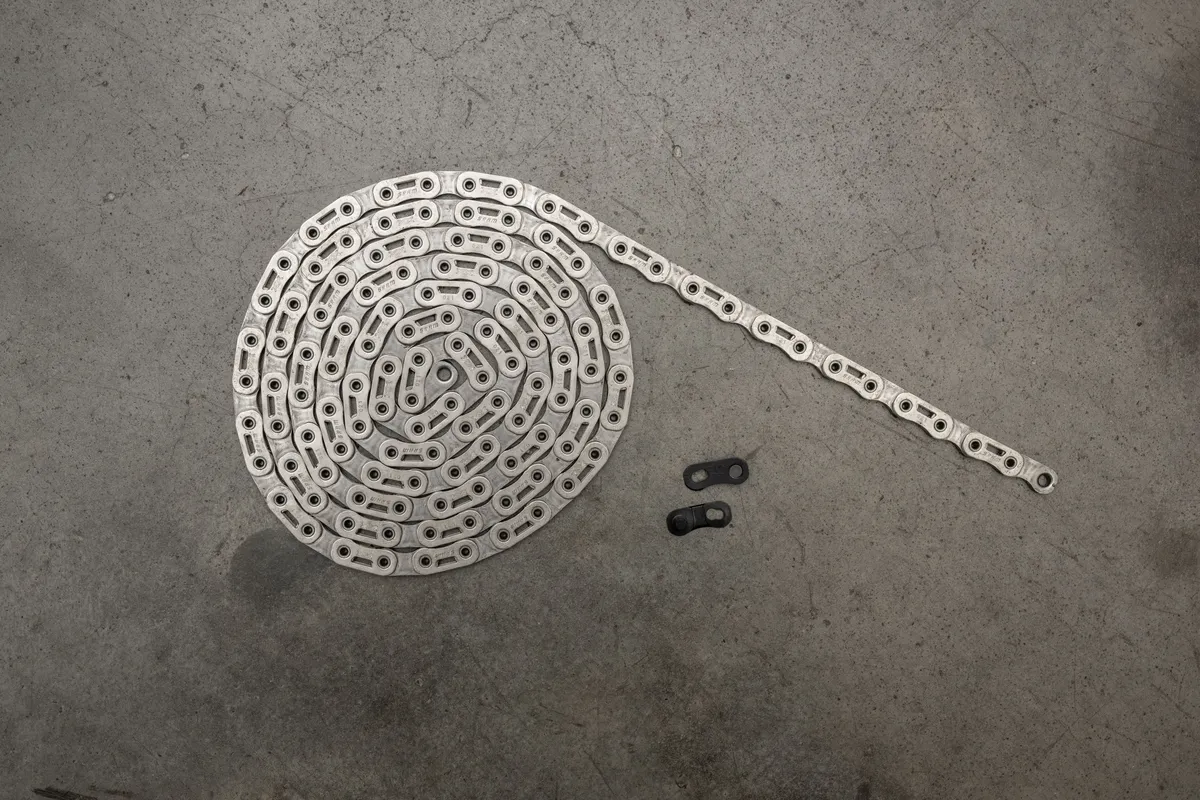
Shift ramps and X-Sync teeth are combined with firmware-based derailleur Cassette Mapping.
The timing created by the cassette’s X-Sync tooth pattern means the derailleur’s shift sequence aligns with the shift ramps; it only shifts to the next gear when it is permitted to do so by the cassette and when the firmware knows a ramp is ‘available’.
With the bike in a stand, this is evident: press the shift button repeatedly while turning the cranks slowly and there is a delay between the button press and the derailleur’s shift.
This has all been done to improve on-power shifting, with SRAM claiming it “shift[s] perfectly under load”, even withstanding a “1,000-watt surge of power on your eMTB in a full sprint”.
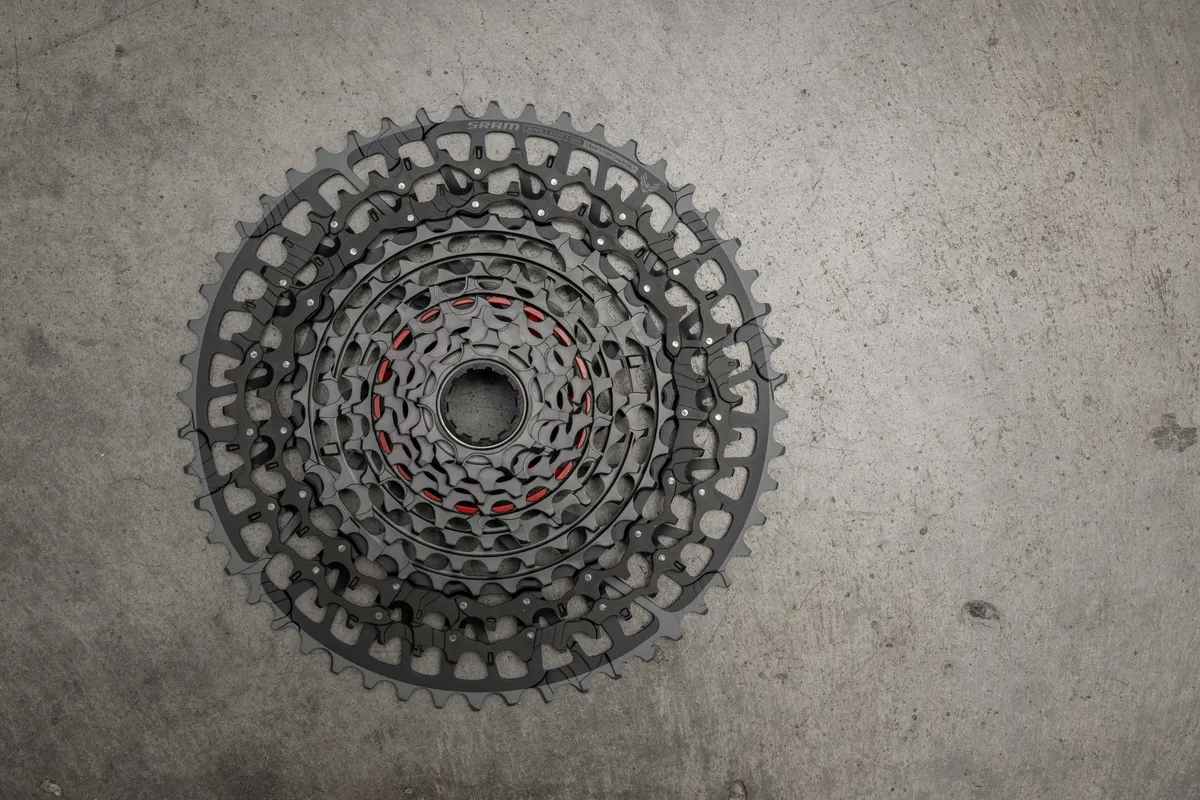
The cassette’s 55mm chain line is said to improve wear life and create less extreme chain angles between the cassette and chainring. It has been moved outboard by 2.5mm compared to Eagle drivetrain cassettes.
Its ratios have been updated too. Retaining the Eagle drivetrain’s 520 per cent range, the second and third biggest cogs are now 44t and 38t respectively (up from 42t and 36t).
The cassette’s sprocket sizes are: 10, 12, 14, 16, 18, 21, 24, 28, 32, 38, 44 and 52.
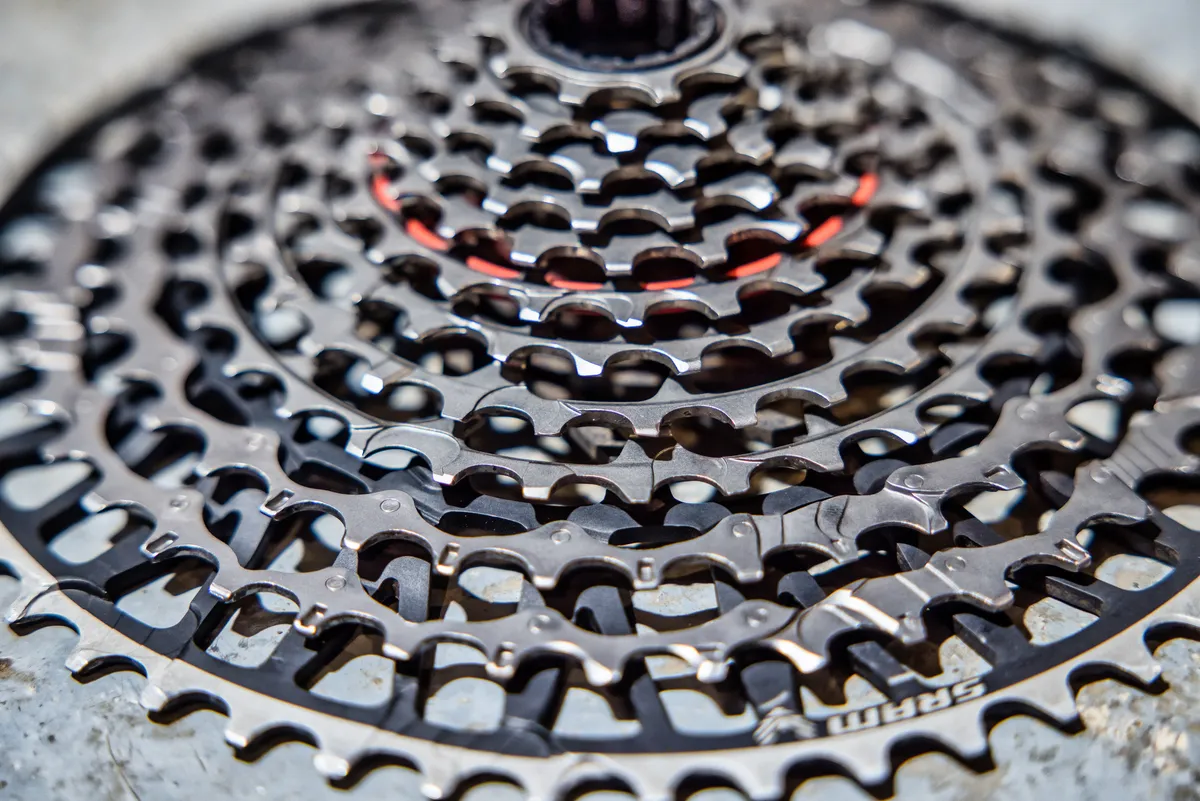
X0 and XX cassettes have aluminium 52t sprockets. The 42t and 36t are made from stamped steel, and the remaining 10-32t are machined steel.
The XX SL cassette has three aluminium sprockets (38t, 44t and 52t) pinned to an aluminium spider. The remaining sprockets are forged and CNC machined from steel.
Each cassette has a red elastomer behind the seventh gear to denote the setup cog, used when installing the Eagle Transmission.
T-Type Eagle Transmission Flattop chain
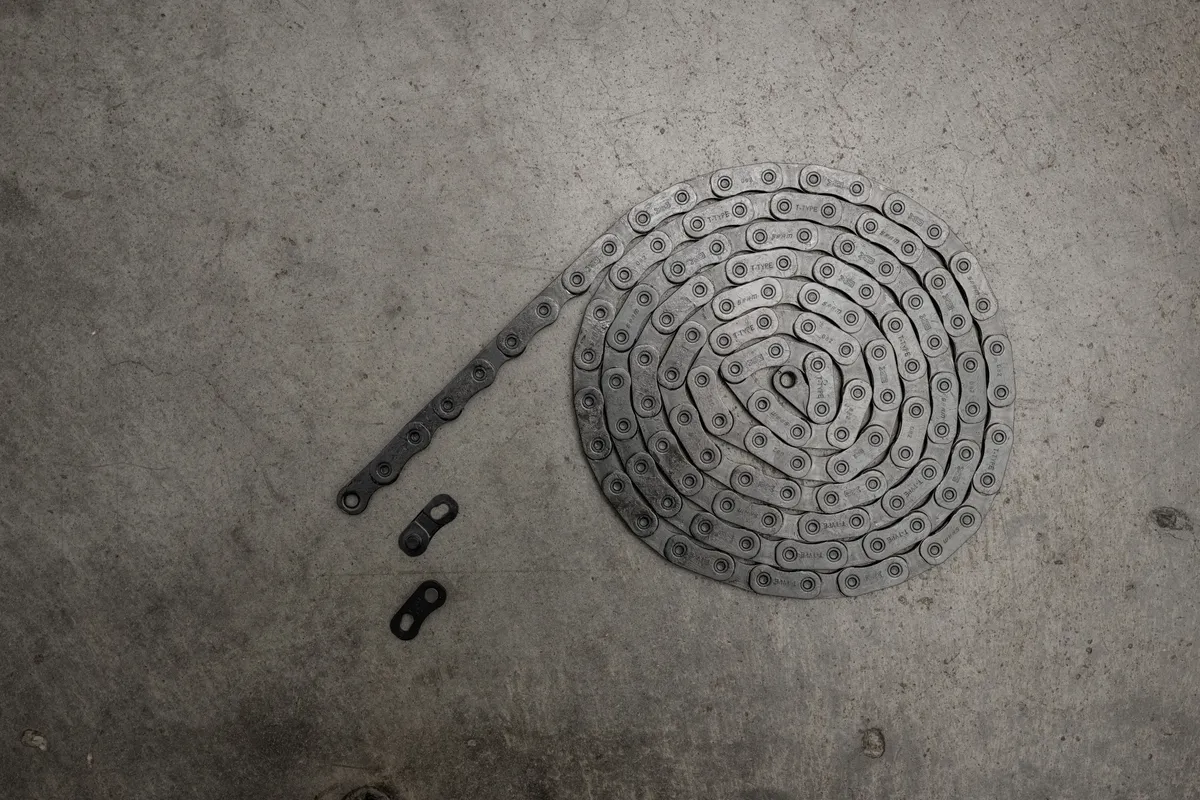
Taking cues from SRAM’s road bike chains, the new T-Type chain’s top portion is flat.
The visual redesign is paired with a new width and improved strength to accommodate increased shifting forces.
The XX SL version saves weight with hollow outer plates and pins, offering an “unprecedented” strength-to-weight ratio.
XX-level chains forego the hollow plates but keep hollow pins. Claimed to be SRAM’s strongest-ever chain, its hard chrome finish is designed to improve wear life.
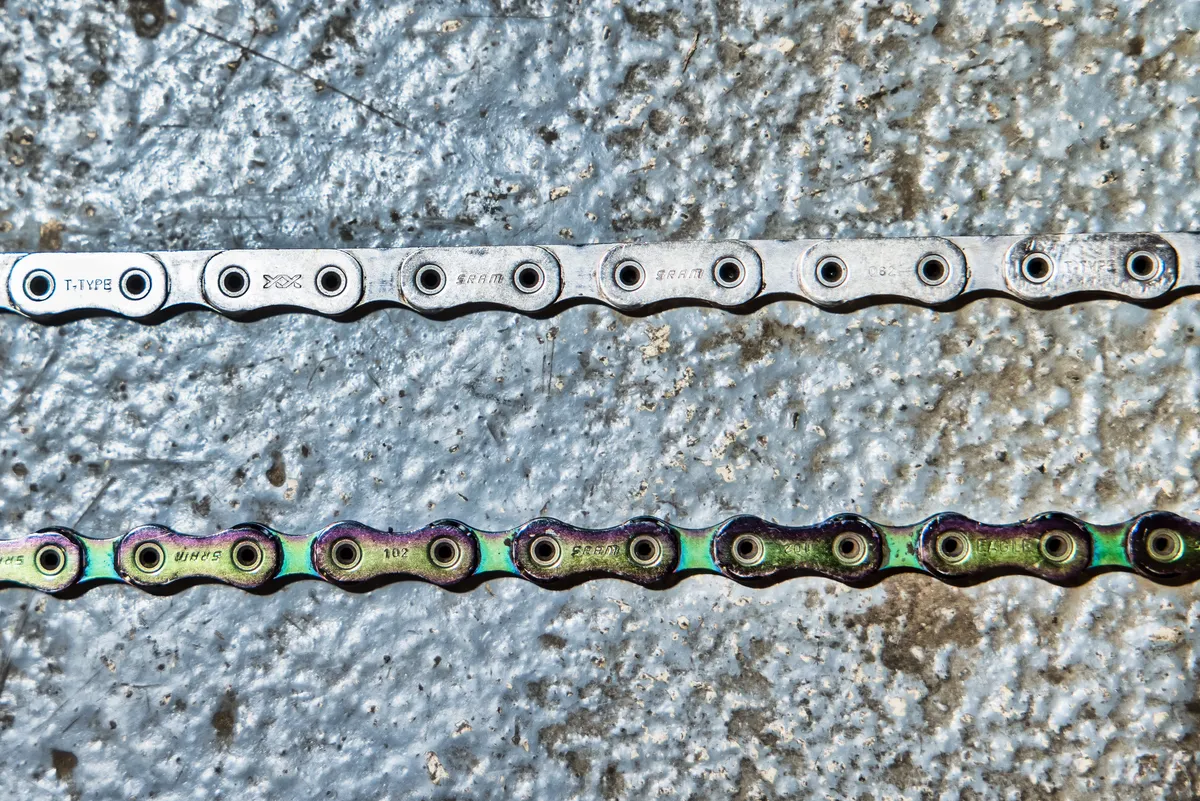
The X0 chain has solid pins and plates. Its Dark Polar finish has a Physical Vapour Deposition (PVD) coating to resist corrosion and wear.
XX and X0 chains are rated for use on electric mountain bikes, but according to SRAM the XX SL chain isn’t suitable.
Specific Flattop Powerlocks have been developed for T-Type.
T-Type Eagle Transmission chainrings
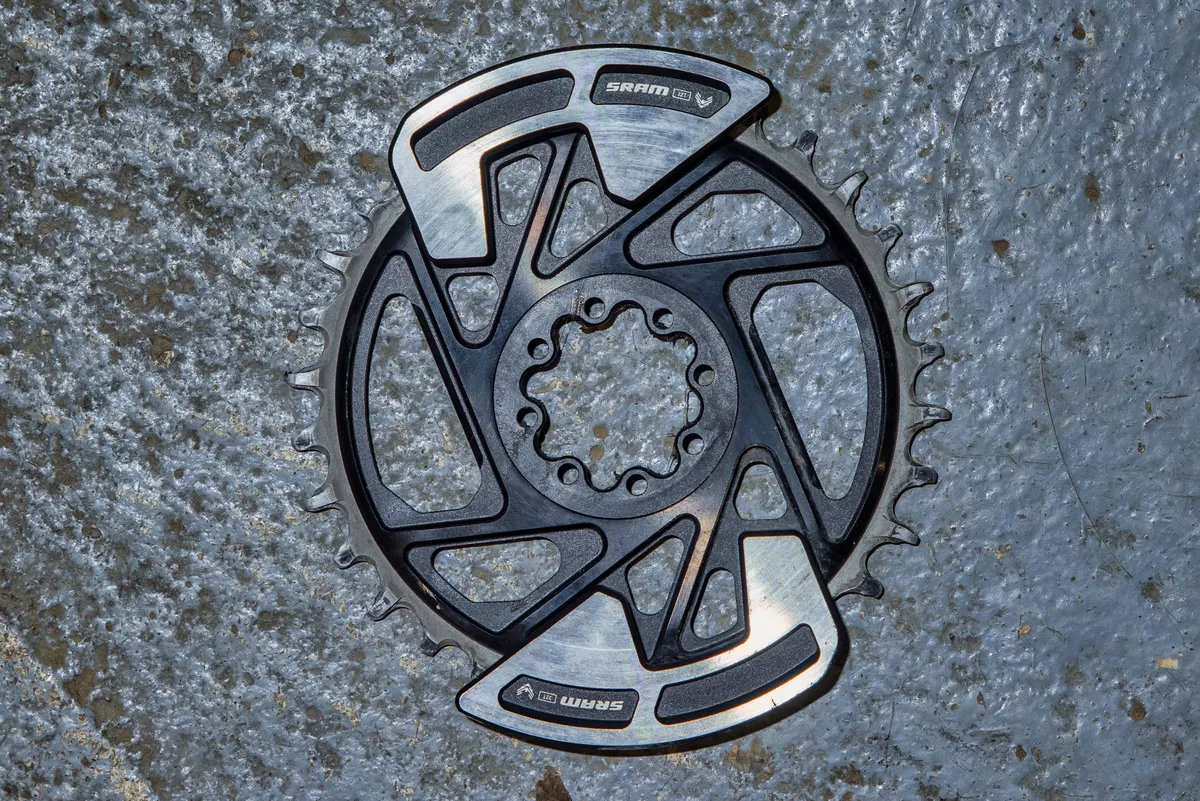
T-Type chainrings have an updated X-Sync tooth profile, despite sharing the nomenclature of the previous Eagle drivetrains.
According to SRAM, T-Type chainrings are backwards compatible with Eagle drivetrain chains, but Eagle drivetrain chainrings are not compatible with T-Type Transmission chains and cassettes.
T-Type chainrings use an 8-bolt direct-mount design and are available in sizes between 30t and 38t (in 2t jumps) depending on model.
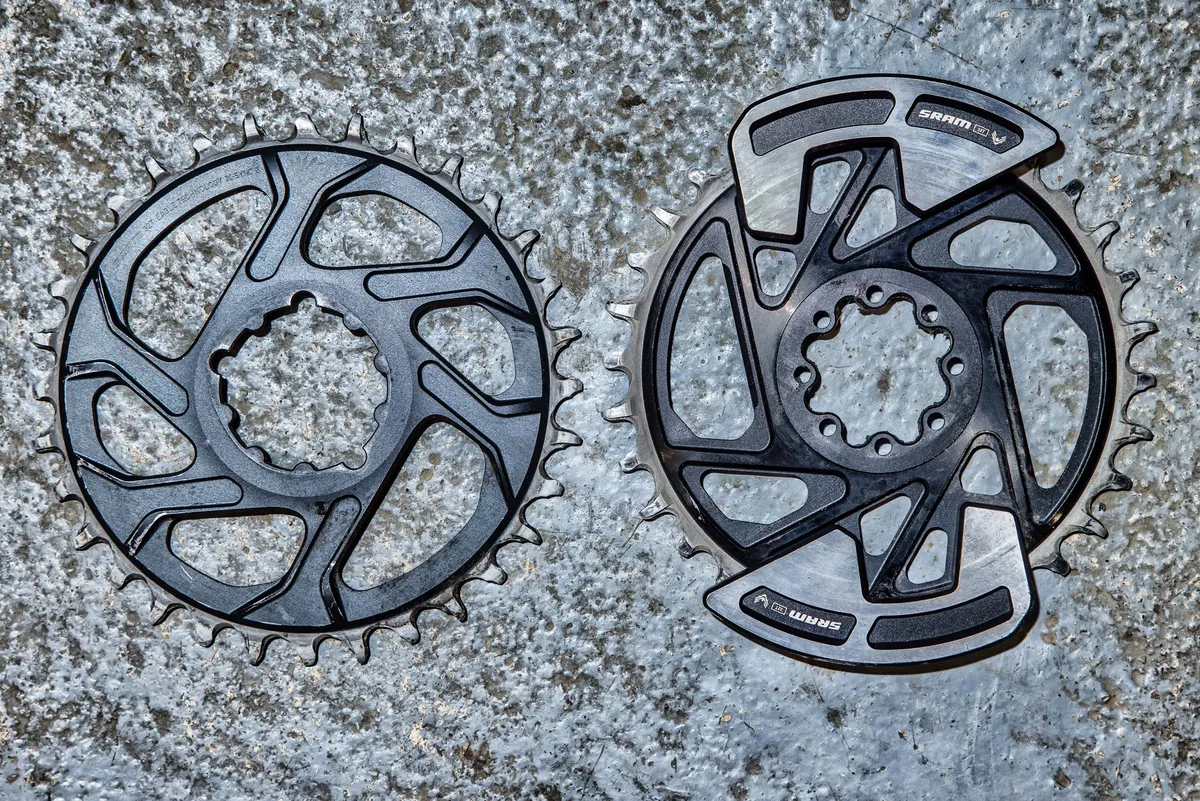
XX and X0 chainrings are compatible with a removable and replaceable, two-position bash guard. The XX SL chainring is designed to be as light as possible, with machined sections to save weight.
An XX SL threaded-mount power meter chainring is also available.
Electric mountain bike chainrings are also available. SRAM makes chainrings for Bosch, Brose, Shimano STEPS and 104 BCD motors.
SRAM T-Type Eagle Transmission crankset and power meters
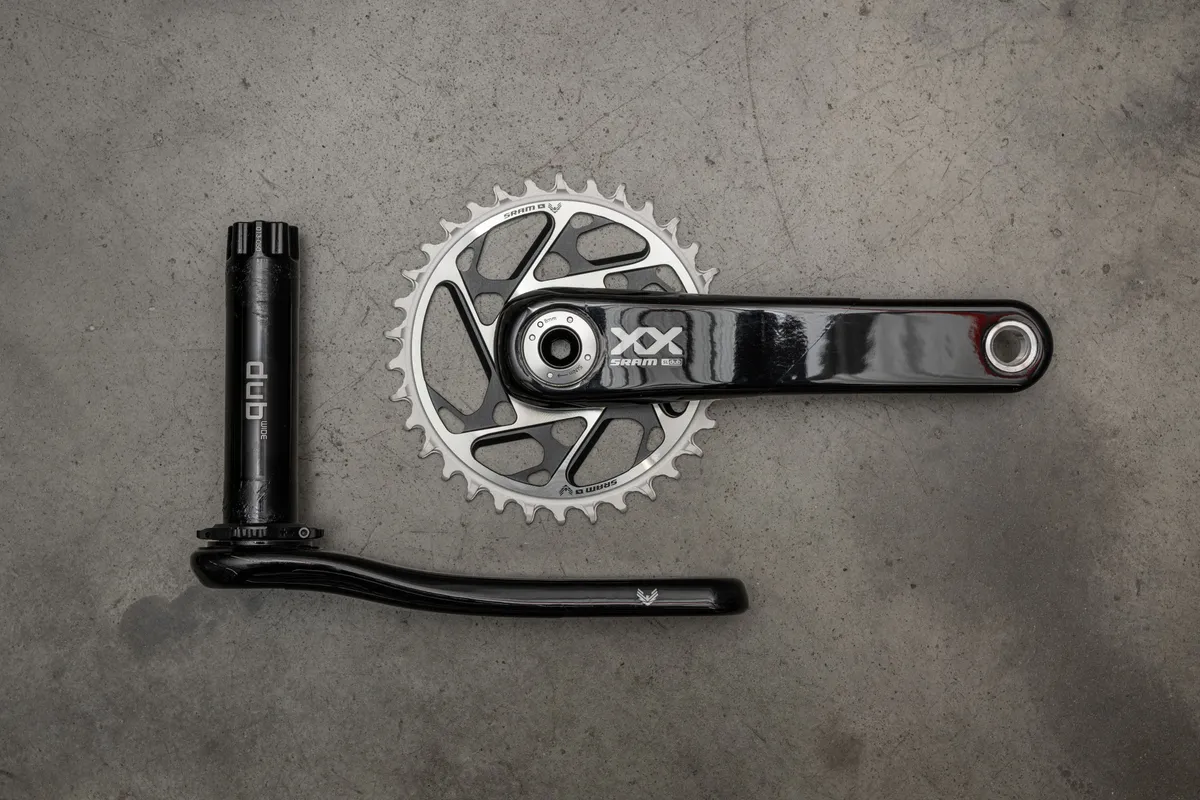
The new cranksets are available in three versions.
XX SL cranks use a carbon fibre hollow-core design. SRAM claims they’re the lightest ISO-certified crank on the market.
The XX version still uses a carbon fibre construction, but has a foam core for improved strength.
X0 cranks, for the first time, are made from aluminium instead of carbon fibre.
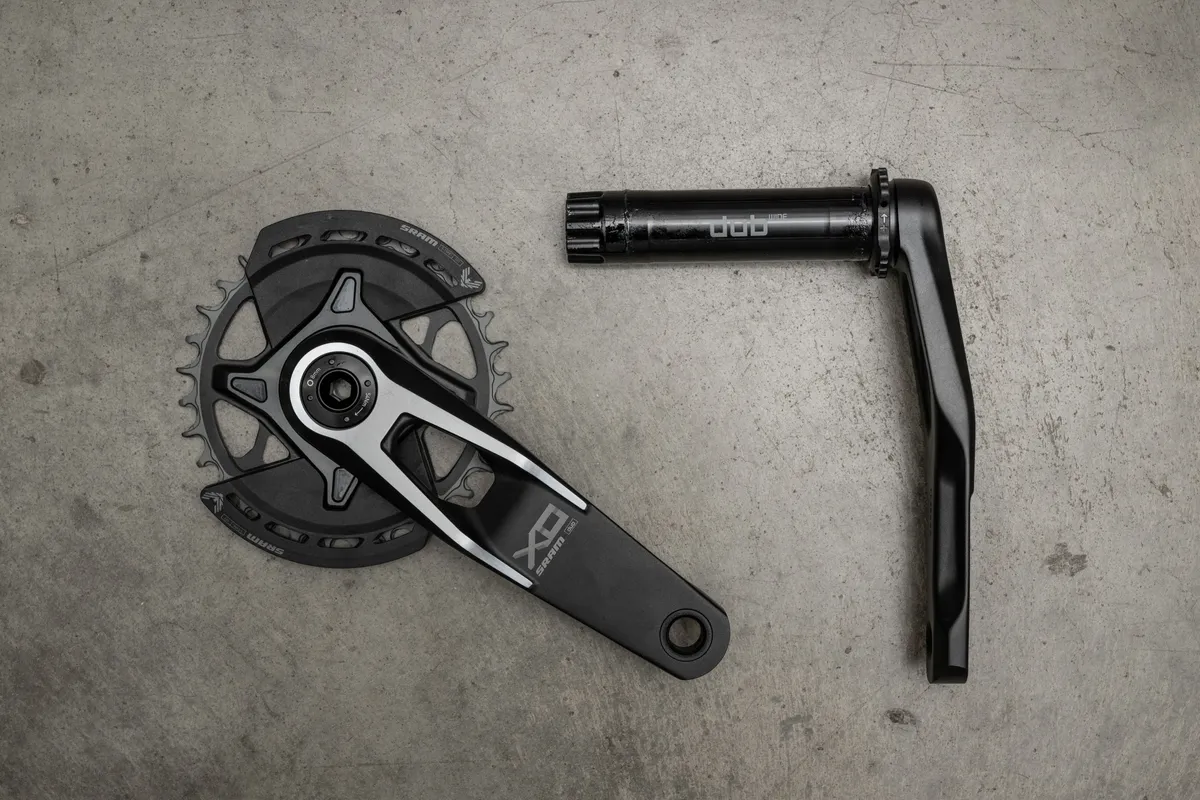
They have the most striking appearance of the new T-Type range thanks to a cut-out portion designed to save weight without sacrificing stiffness.
A polished area is claimed to help reduce the visually degrading effects of scuffing.
XX and X0 eMTB cranks are also available.
Each of the cranksets is available in 165mm, 170mm and 175mm lengths.
SRAM T-Type Eagle Transmission power meters
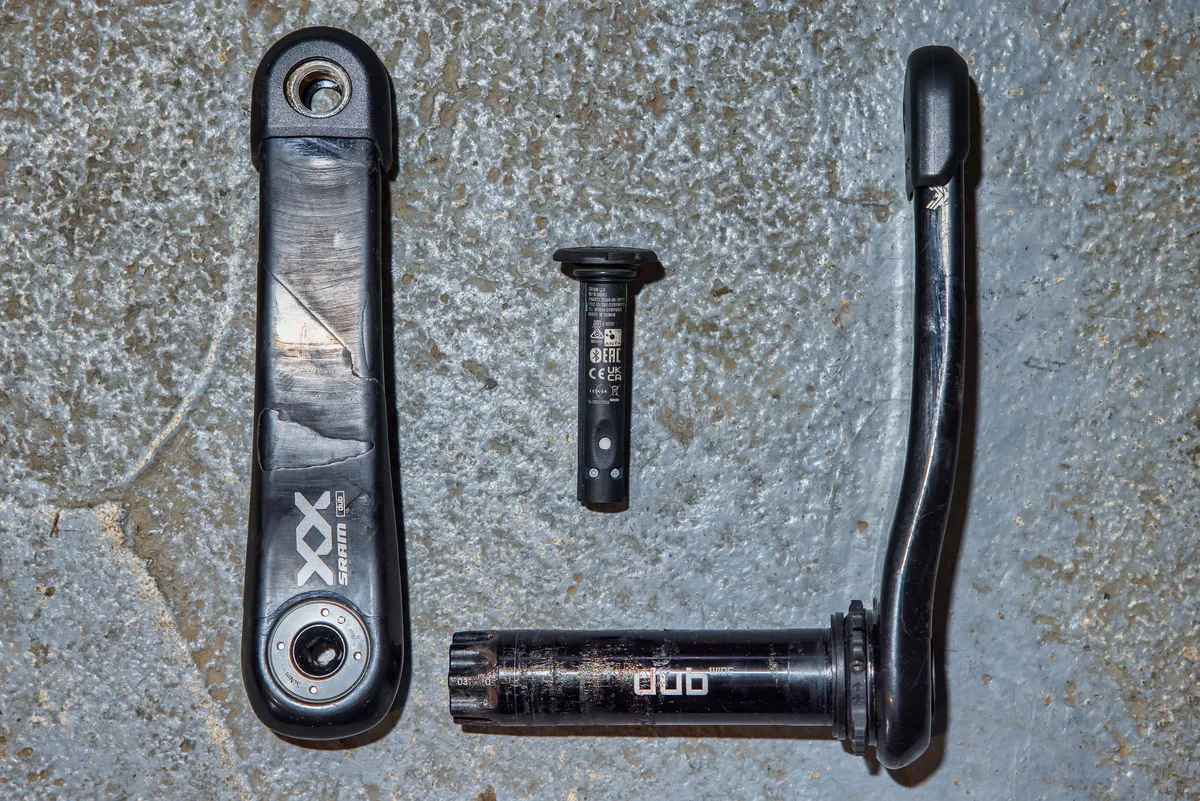
All the cranksets are power-meter ready, but dedicated XX SL, XX and X0 power meter versions are also available.
The XX SL crankset uses a dual-sided spider-based power meter with replaceable threaded chainring.
SRAM claims it has a +/- 1.5 per cent accuracy rating. It boasts a 200-hour battery life from the replaceable CR2032 coin cell.
It connects via Bluetooth and is compatible with RockShox’s Flight Attendant automatic suspension adjustment system.
MagicZero technology is claimed to automatically recalibrate the power meter as you ride, and it doesn’t need a cadence magnet.
It has an IPX7 waterproof rating.
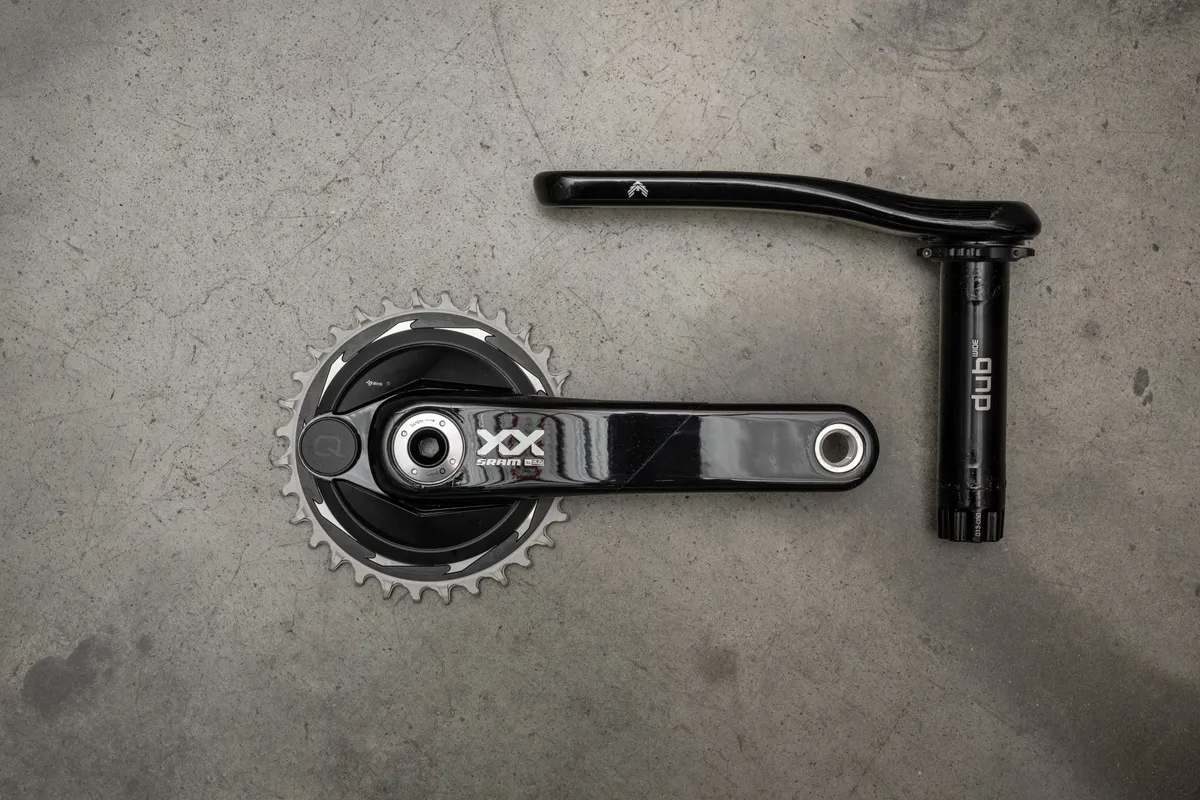
The XX and X0 cranksets use an axle-based DUB-PWR power meter. This houses Quarq’s power meter inside the crank axle spindle.
It measures left-side power to calculate total watts, with a claimed accuracy of +/- 3 per cent.
It uses AAA lithium batteries with a claimed 400-hour life. It’s IPX7 waterproof-rated and connects via Bluetooth.
It’s compatible with RockShox Flight Attendant and can be used with T-Type chainrings with bash guards.
XX and X0 left-hand crank arms with power meters are available as an aftermarket upgrade.
Is SRAM’s new T-Type Eagle Transmission compatible with SRAM Eagle drivetrains?
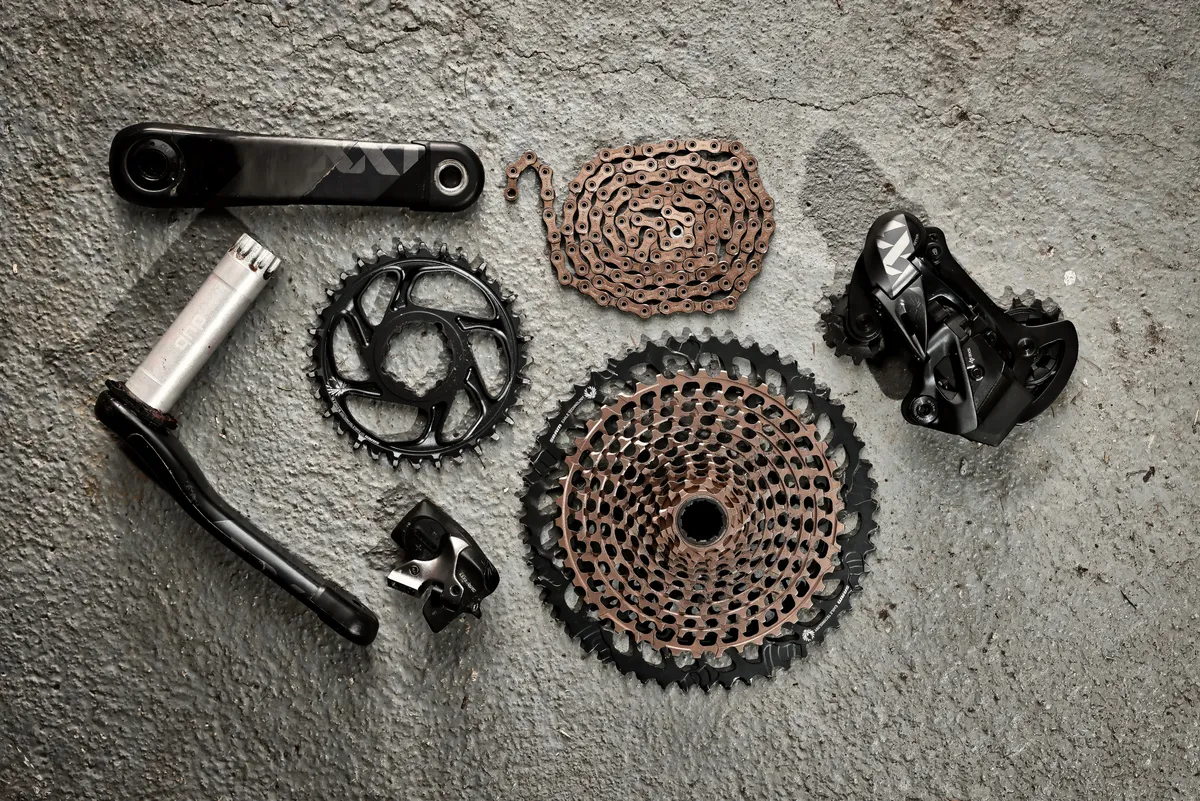
In short, no, the new T-Type Eagle Transmission is not compatible with any existing Eagle drivetrain components.
Mixing Eagle Transmission and Eagle drivetrain derailleurs, cassettes, chainrings and chains is not possible.
The exception to this rule is the Eagle drivetrain AXS controllers and AXS Pod Controllers, which are inter-compatible.
Additionally, T-Type Eagle Transmission chainrings are compatible with Eagle drivetrain chains, but Eagle drivetrain chainrings are not compatible with T-Type components.
Is my bike compatible with SRAM’s new T-Type Eagle Transmission?

Any bike that fulfils SRAM’s UDH Specification with a Hangerless Interface is compatible with SRAM’s new T-Type Eagle Transmission.
If you’re unsure whether your bike uses SRAM’s UDH, you can check on the UDH compatible bike finder web page.
SRAM T-Type Eagle Transmission weights
Prior to the launch of Eagle Transmission, we were able to weigh full XX SL and XX Powermeter T-Type groupsets.
Without a power meter, the XX SL groupset weighed 1,533g, slightly less than an equivalent Shimano M9100 XTR groupset (1,547g).
With a power meter, this bumped up to 1,709g.
| Component | Weight (g) |
|---|---|
| XX SL T-Type Eagle Transmission derailleur | 417.8 |
| T-Type Eagle Transmission AXS Pod Controller Ultimate (with Inifinty Loop) | 47.43 |
| XX SL T-Type Eagle Transmission cassette | 344.83 |
| XX SL T-Type Eagle Transmission 126 link chain | 265.16 |
| XX SL T-Type Eagle Transmission 32t power meter chainring | 142.6 |
| XX SL T-Type Eagle Transmission threaded power meter | 105.38 |
| XX SL T-Type Eagle Transmission 170mm cranks | 386.42 |
| Total weight: | 1,709.62 |
The XX groupset with in-built DUB-PWR power meter weighed 1,785g, making it 96g lighter than an equivalent Shimano XT M8100 groupset and 252g heavier than an equivalent XTR M9100 group.
| Component | Weight (g) |
|---|---|
| XX T-Type Eagle Transmission derailleur | 472 |
| T-Type Eagle Transmission AXS Pod Controller Ultimate (with Bridge Clamp) | 55 |
| XX T-Type Eagle Transmission cassette | 384 |
| XX T-Type Eagle Transmission 126-link chain with Power Lock | 274 |
| XX T-Type Eagle Transmission 32t chainring with bash guards | 129 |
| XX T-Type Eagle Transmission 170mm cranks with DUB-PWR powermeter | 471 |
| Total weight: | 1,785 |
SRAM has provided some claimed weights for its T-Type Eagle Transmission components.
| Component | Weight (g) |
|---|---|
| XX SL T-Type Eagle Transmission derailleur | 440 |
| XX T-Type Eagle Transmission derailleur | 465 |
| X0 SL T-Type Eagle Transmission derailleur | 475 |
| T-Type Eagle Transmission AXS Pod Controller | 48 |
| XX SL T-Type Eagle Transmission cassette | 345 |
| XX T-Type Eagle Transmission cassette | 380 |
| X0 T-Type Eagle Transmission cassette | 380 |
| XX SL T-Type Eagle Transmission 126 link chain | 240 |
| XX T-Type Eagle Transmission 126 link chain | 247 |
| X0 T-Type Eagle Transmission 126 link chain | 256 |
SRAM T-Type Eagle Transmission groupset and individual component prices
Eight variants of T-Type Eagle Transmission groupsets will be available to buy.
A groupset’s core parts include the rear derailleur (with battery and charger), AXS Pod Controller (with Infinity Clamp), cassette, chain, chainring and cranks.
Power meter groupsets add a power meter to that list, while ebike groupsets remove the chainring.
- XX SL T-Type Eagle Transmission Powermeter AXS groupset: £2,890 / $2,699 / €3,350
- XX SL T-Type Eagle Transmission AXS groupset: £2,355 / $2,199 / €2,650
- XX T-Type Eagle Transmission Powermeter AXS groupset: £2,465 / $2,299 / €2,750
- XX T-Type Eagle Transmission AXS groupset: £2,195 / £2,049 / €2,450
- X0 T-Type Eagle Transmission AXS groupset: £1,713 / $1,599 / €1,900
Electric mountain bike groupsets:
- XX T-Type Eagle E-MTB Transmission AXS groupset: from £1,530 / $1,599 / €1,700 to £1,800 / $1,849 / €2,000
- X0 T-Type Eagle E-MTB Transmission AXS groupset: from £1,240 / $1,299 / €1,370 to £1,400 / $1,499 / €1,550
Below is a list of all the T-Type Eagle Transmission components and their prices.
| Component | Price £ | Price $ | Price € |
|---|---|---|---|
| XX SL T-Type Eagle Transmission derailleur (without battery) | 695 | 650 | 700 |
| XX T-Type Eagle Transmission derailleur (without battery) | 695 | 650 | 700 |
| X0 T-Type Eagle Transmission derailleur (without battery) | 590 | 555 | 660 |
| AXS Pod Controller Ultaimte with Inifinty Clamp | 215 | 200 | 240 |
| AXS Pod Controller with Inifinty Clamp | 165 | 150 | 180 |
| XX SL T-Type Eagle Transmission crankset (without bottom bracket, with chainring) | 590 | 550 | 660 |
| XX T-Type Eagle Transmission crankset (without bottom bracket, with bash guards) | 535 | 500 | 600 |
| X0 T-Type Eagle Transmission crankset (without bottom bracket, with bash guards) | 320 | 300 | 360 |
| XX crankarm assembly for EMTB (without crank cap, bottom bracket, chainring) | 270 | 250 | 300 |
| X0 crankarm assembly for EMTB (without crank cap, bottom bracket, chainring) | 160 | 150 | 180 |
| XX SL T-Type Eagle Transmission Powermeter crankset (without bottom bracket, with chainring) | 1,125 | 1,050 | 1,260 |
| XX T-Type Eagle Transmission Powermeter crankset (without bottom bracket, with chainring) | 1020 | 650 | 1,140 |
| X0 T-Type Eagle Transmission Powermeter crankset (without bottom bracket, with chainring) | 430 | 400 | 480 |
| XX SL XG-1299 T-Type Eagle Transmission 10-52t 12-speed cassette | 645 | 600 | 720 |
| XX XG-1297 T-Type Eagle Transmission 10-52t 12-speed cassette | 590 | 550 | 660 |
| X0 XG-1295 T-Type Eagle Transmission 10-52t 12-speed cassette | 430 | 400 | 480 |
| XX SL T-Type Eagle Transmission HollowPin 126-link chain black PVD | 160 | 150 | 180 |
| XX T-Type Eagle Transmission HollowPin 126-link chain black PVD | 135 | 125 | 150 |
| X0 T-Type Eagle Transmission HollowPin 126-link chain black PVD | 105 | 100 | 120 |
| T-Type Eagle Transmission PowerLock black (4 pieces) | 17 | 18 | 19 |
| T-Type Eagle Transmission PowerLock black PVD (4 pieces) | 24 | 25 | 27 |
| XX SL T-Type Eagle Transmission chainring (all sizes, all offsets) | 124 | 128 | 139 |
| XX T-Type Eagle Transmission chainring (all sizes, all offsets) | 100 | 107 | 112 |
| X0 T-Type Eagle Transmission chainring (all sizes, all offsets) | 72 | 74 | 80 |
| XX SL T-Type Eagle Transmission Powermeter threaded chainring (all sizes, all offsets) | 124 | 128 | 139 |
| T-Type Eagle Transmission eMTB chainring (104 BCD and CL55 Bosch Gen 4 Direct Mount) | 43 | 42 | 47 |
| XX T-Type Eagle Transmission eMTB chainring (Bosch Gen 4 direct mount, Brose, Shimano STEPS) | 100 | 107 | 112 |
SRAM T-Type Eagle Transmission spare parts
At T-Type’s launch, SRAM was coy about specifics on spare part availability and pricing.
The brand has assured us the derailleur’s rebuildable portions will be available to buy from retailers.
SRAM T-Type Eagle Transmission glossary

- T-Type Eagle Transmission: the overarching name of SRAM’s latest components. The name draws a clear distinction between this generation of products and previous Eagle drivetrain parts
- Eagle drivetrain: this refers to all previous Eagle drivetrain components
- UDH: stands for Universal Derailleur Hanger, and is the standard required for T-Type components to be compatible with a bike
- Hangerless Interface: UDH-compatible bikes will have a Hangerless Interface. This is required for T-Type derailleur compatibility
- Full Mount: used to describe how T-Type derailleurs engage or clamp both the inboard and outboard faces of the frame’s Hangerless Interface
- Skid Plates: replaceable and removable sections of the derailleur that help protect it from damage
- Inline Cage: used to describe the T-Type derailleur’s cage, that lines up with the bike’s chainring and cassette
- Magic Wheel: thanks to its design, it permits continued chain movement even if the pulley wheel is blocked
- Cage Mode button: used to move the derailleur into its Setup, Open or Ride modes, previously known as the Cage Lock button
- Setup Key: the Cage Mode button is also used as the Setup Key, that has an A or B position. Depending on the frame the derailleur is fitted to, one of those positions will be needed for correct setup
- AXS Pod Controller: SRAM’s terminology for a T-Type gear shifter
- Infinity Clamp: the AXS Pod Controller's bar mount
- Bridge Clamp: the AXS Pod Controller’s dedicated brake lever mount, previously known as Matchmaker X
- X-Sync: the alternating width tooth profile used on T-Type cassettes, chainrings and derailleur jockey wheels
- Cassette Mapping: firmware within T-Type rear derailleurs that aids shift performance
- MagicZero: the chainring-based power meter’s passive in-built self-calibration tool
- DUB-PWR: one-sided power meter that’s built into left-hand T-Type pedal crank axles
